119 Oldest and Most Significant Cultures and Civilizations
This is a fact that the earliest human-like species first appeared around 2 million years ago. However, early Homo Sapiens, which were modern humans, are relatively new to earth. They first appeared in Africa around 200,00 years ago. For thousands of years, after modern humans appeared for the first time, early man laid the foundations for human civilization. The development of agriculture, art, social structure, philosophy, and politics then followed. The Mesopotamians are generally considered the primitive urban civilization in the world. However, several earlier men developed societies and cultures that can also be called civilizations. In India, civilization appeared with an inexplicable culture along the Indus River and also in farming societies in the southern part. The complete history of these cultures and civilizations is quite complex. Below, you can find the list of significant cultures and civilizations to know more about them.
Abbevillian
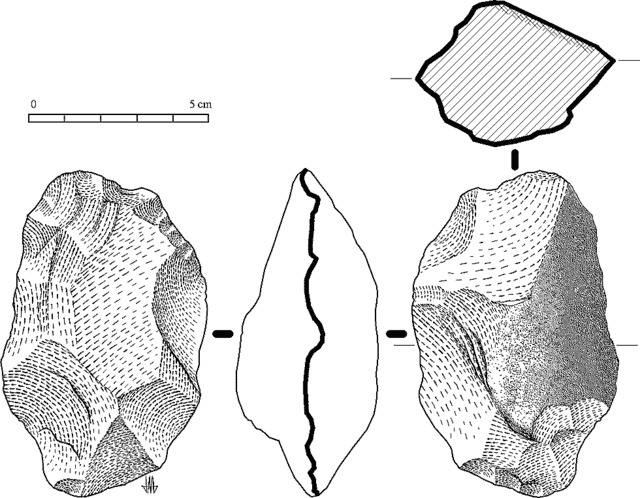
The original artifacts were collected from road construction sites on the Somme river near Abbeville by a French customs officer, Boucher de Perthes. He published his findings in 1836. Subsequently, Louis Laurent Gabriel de Mortillet (1821–1898), professor of prehistoric anthropology at the School of Anthropology in Paris, published (1882) “Le Prehistorique, antiquité de l’homme”, in which he was the first to characterize periods by the name of a site.
Read More About Abbevillian / Source
Acheulean
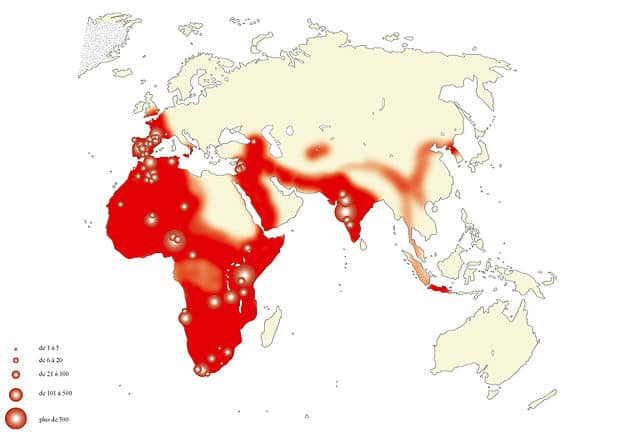
Acheulean (also Acheulian and Mode II), from the French acheuléen after the type site of Saint-Acheul, is an archaeological industry of stone tool manufacture characterized by distinctive oval and pear-shaped “hand-axes” associated with Homo erectus and derived species such as Homo heidelbergensis.
Acheulean tools were produced during the Lower Palaeolithic era across Africa and much of West Asia, South Asia, East Asia and Europe, and are typically found with Homo erectus remains. It is thought that Acheulean technologies first developed about 1.76 million years ago, derived from the more primitive Oldowan technology associated with Homo habilis.
The Acheulean includes at least the early part of the Middle Paleolithic. Its end is not well defined, depending on whether Sangoan (also known as “Epi-Acheulean”) is included, it may be taken to last until as late as 130,000 years ago. In Europe and Western Asia, early Neanderthals adopted Acheulean technology, transitioning to Mousterian by about 160,000 years ago.
Read More About Acheulean / Source
Sumer
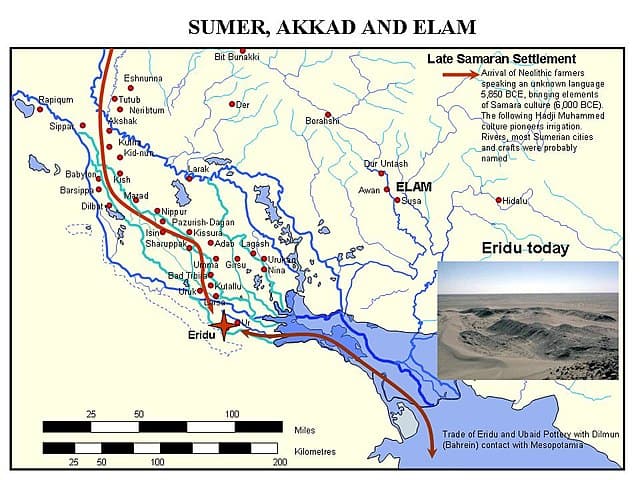
Sumer is the earliest known civilization in the historical region of southern Mesopotamia (now southern Iraq), emerging during the Chalcolithic and early Bronze Ages between the sixth and fifth millennium BC. It is also one of the first civilizations in the world, along with Ancient Egypt, Norte Chico, the Minoan civilization, and the Indus Valley Civilization. Living along the valleys of the Tigris and Euphrates, Sumerian farmers grew an abundance of grain and other crops, the surplus from which enabled them to form urban settlements. Proto-writing dates back before 3000 BC. The earliest texts come from the cities of Uruk and Jemdet Nasr, and date to between c. 3500 and c. 3000 BC.
Read More About Sumer / Source
Aboriginal Australians
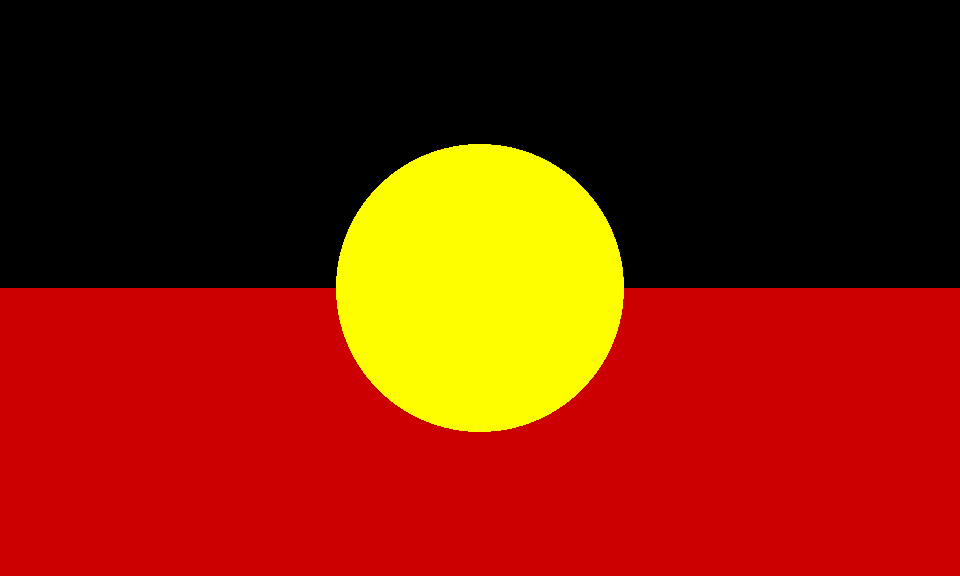
Aboriginal Australians are the various Indigenous peoples of the Australian mainland and many of its islands, such as Tasmania, Fraser Island, Hinchinbrook Island, the Tiwi Islands, and Groote Eylandt, but excluding the Torres Strait Islands. The term Indigenous Australians refers to Aboriginal Australians and Torres Strait Islanders collectively. It is generally used when both groups are included in the topic being addressed. Torres Strait Islanders are ethnically and culturally distinct, despite extensive cultural exchange with some of the Aboriginal groups. The Torres Strait Islands are mostly part of Queensland but have a separate governmental status.
Aboriginal Australians comprise many distinct peoples who have developed across Australia for over 50,000 years. These peoples have a broadly shared, though complex, genetic history, but it is only in the last two hundred years that they have been defined and started to self-identify as a single group. The definition of the term “Aboriginal” has changed over time and place, with family lineage, self-identification and community acceptance all being of varying importance.
Read More About Aboriginal Australians / Source
African civilization
The terms African civilizations, also classical African civilizations, or African empires are terms that generally refer to the various pre-colonial African kingdoms. The civilizations usually include Egypt, Carthage, Axum, Numidia, and Nubia, but may also be extended to the prehistoric Land of Punt and others: the Empire of Ashanti, Kingdom of Kongo, Empire of Mali, Kingdom of Zimbabwe, Songhai Empire, the Garamantes the Empire of Ghana, Bono state and Kingdom of Benin.
Read More About African civilization / Source
Aksum
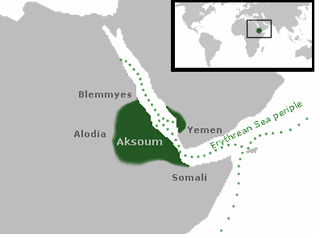
The Kingdom of Aksum, also known as the Kingdom of Axum or the Aksumite Empire, was an ancient kingdom that controlled Eritrea, Northern Ethiopia, parts of Eastern Sudan and Southern Yemen at its peak. The Kingdom of Aksum, also known as the Kingdom of Axum or the Aksumite Empire, was an ancient Ethiopian kingdom that spanned what are now Eritrea, northern Ethiopia, much of eastern Sudan and southern/eastern Yemen at its peak. It was centralized in Northern Ethiopia, with its capital in the city of Aksum or Axum. Aksumite rulers styled themselves as King of kings, king of Aksum, Himyar, Raydan, Saba, Salhen, Tsiyamo, Beja and of Kush. Ruled by the Aksumites, it existed from approximately 80 BC to AD 825.
Read More About Aksum / Source
Assyrian
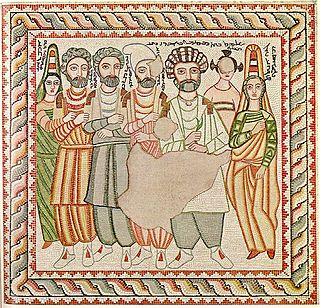
The history of the Assyrian people begins with the appearance of Akkadian speaking peoples in Mesopotamia at some point between 3500 and 3000 BC, followed by the formation of Assyria in the 25th century BC. During the early Bronze Age period Sargon of Akkad united all the native Semitic-speakers and the Sumerians of Mesopotamia (including the Assyrians) under the Akkadian Empire (2335–2154 BC). Assyria essentially existed as part of a unified Akkadian nation for much of the period from the 24th century BC to the 22nd century BC, and a nation-state from the mid 21st century BC until its destruction as an independent state between 615–599 BC.
The Assyrians are culturally, linguistically, genetically and ethnically distinct from their neighbours in the Middle East – the Arabs, Syrians, Persians/Iranians, Kurds, Jews, Turks, Israelis, Azeris, Shabaks, Yezidis, Kawliya, Mandeans and Armenians.
Read More About Assyrian / Source
Badarian culture
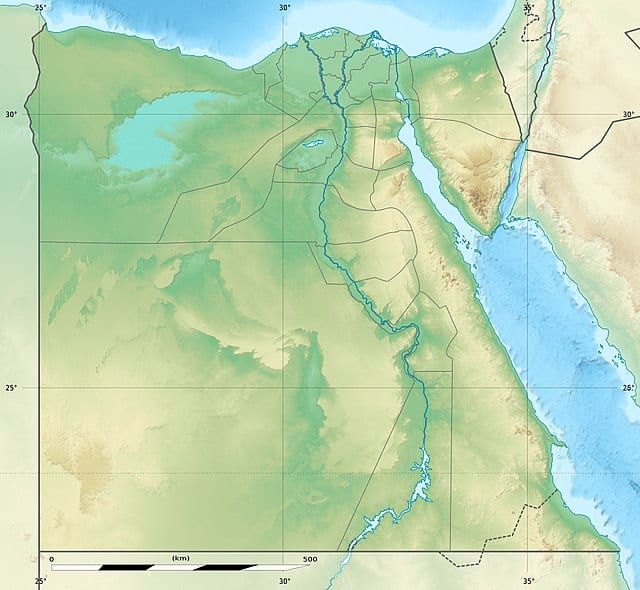
The Badarian culture provides the earliest direct evidence of agriculture in Upper Egypt during the Predynastic Era. It flourished between 4400 and 4000 BCE, and might have already emerged by 5000 BCE. It was first identified in El-Badari, Asyut Governorate. About forty settlements and six hundred graves have been located. Social stratification has been inferred from the burying of more prosperous members of the community in a different part of the cemetery. The Badarian economy was based mostly on agriculture, fishing and animal husbandry. Tools included end-scrapers, perforators, axes, bifacial sickles and concave-base arrowheads. Remains of cattle, dogs and sheep were found in the cemeteries. Wheat, barley, lentils and tubers were consumed.
The Badari culture is primarily known from cemeteries in the low desert. The deceased were placed on mats and buried in pits with their heads usually laid to the south, looking west. This seems contiguous with the later dynastic traditions regarding the west as the land of the dead. The pottery that was buried with them is the most characteristic element of the Badarian culture. It had been given a distinctive, decorative rippled surface.
Read More About Badarian culture / Source
Gobekli Tepe
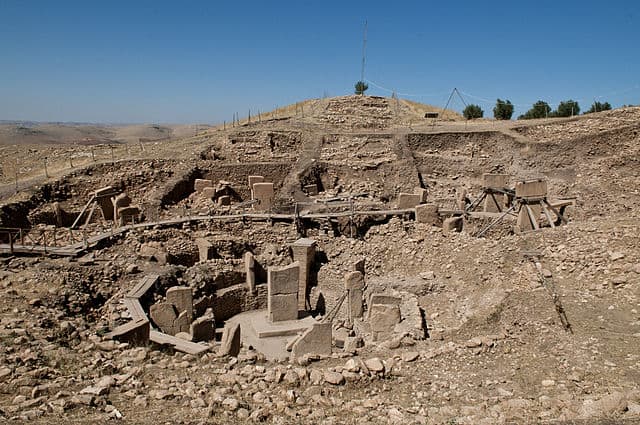
Göbekli Tepe is a Neolithic archaeological site near the city of Şanlıurfa in Southeastern Anatolia, Turkey. The tell or artificial mound has a height of 15 m (50 ft) and is about 300 m (1,000 ft) in diameter, approximately 760 m (2,500 ft) above sea level. It includes two phases of use, believed to be of a social or ritual nature by site discoverer and excavator Klaus Schmidt. Its oldest layer dates to the very beginning of the Neolithic, the Pre-Pottery Neolithic A (PPNA), or roughly the 10th to 9th millennia BCE. The younger phase belongs to the Pre-Pottery Neolithic B, or the 9th to 8th millennia BCE. Still during the early phase, in the 10th millennium BCE, circles of massive T-shaped stone pillars were erected, classified as the oldest known megaliths, some 3,000 years older than the earliest cities of Mesopotamia.
More than 200 pillars in about 20 circles are known (as of May 2020) through geophysical surveys. Each pillar has a height of up to 6 m (20 ft) and weighs up to 10 tons. They are fitted into sockets that were hewn out of the local bedrock. In the second phase, belonging to the Pre-Pottery Neolithic B (PPNB), the erected pillars are smaller and stood in rectangular rooms with floors of polished lime. The site was abandoned after the Pre-Pottery Neolithic B (PPNB). Younger structures date to classical times.
Read More About Gobekli Tepe / Source
Indus Valley Civilisation
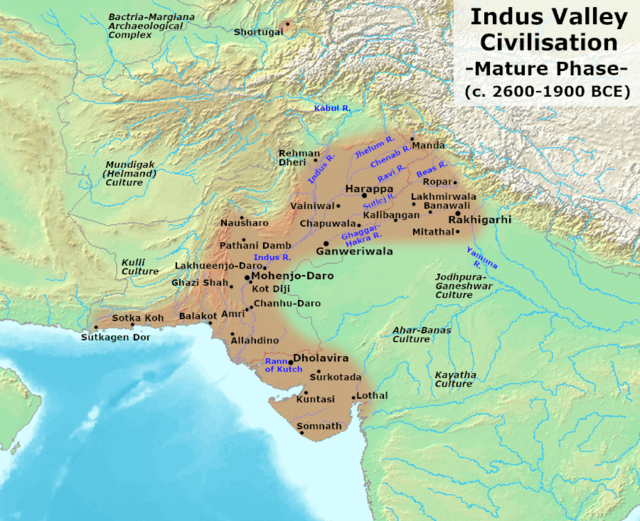
The Indus Valley Civilisation (IVC) was a Bronze Age civilisation in the northwestern regions of South Asia, lasting from 3300 BCE to 1300 BCE, and in its mature form from 2600 BCE to 1900 BCE. Together with ancient Egypt and Mesopotamia, it was one of three early civilisations of the Near East and South Asia, and of the three, the most widespread, its sites spanning an area stretching from northeast Afghanistan, through much of Pakistan, and into western and northwestern India. It flourished in the basins of the Indus River, which flows through the length of Pakistan, and along a system of perennial, mostly monsoon-fed, rivers that once coursed in the vicinity of the seasonal Ghaggar-Hakra river in northwest India and eastern Pakistan.
Read More About Indus Valley Civilisation / Source
Rakhigarhi
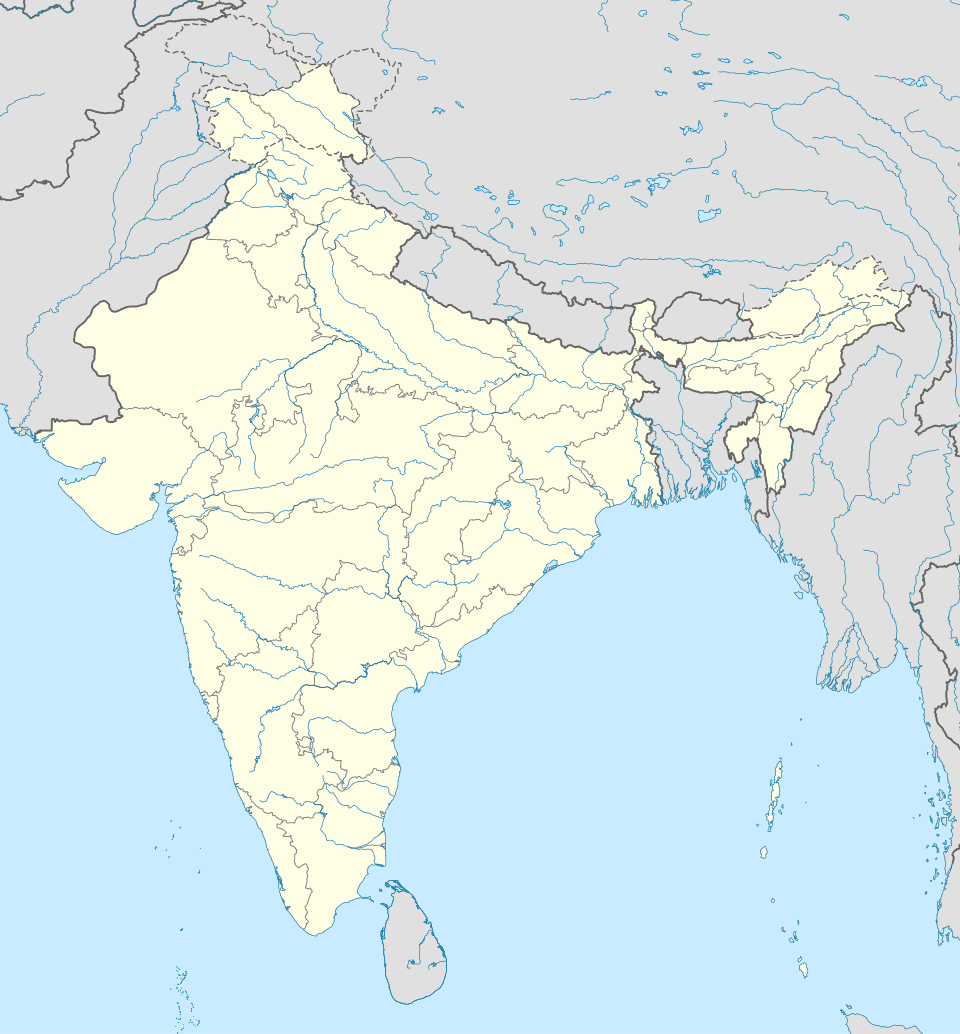
Rakhigarhi, Rakhi Garhi (Rakhi Shahpur + Rakhi Khas), is a village in Hisar District in the state of Haryana in India, situated 150 kilometers to the northwest of Delhi. It is the site of a pre-Indus Valley Civilisation settlement going back to about 6500 BCE. Later, it was also part of the mature Indus Valley Civilisation, dating to 2600-1900 BCE. The site is located in the Ghaggar-Hakra River plain, some 27 km from the seasonal Ghaggar river.
Read More About Rakhigarhi / Source
Ancient Egypt
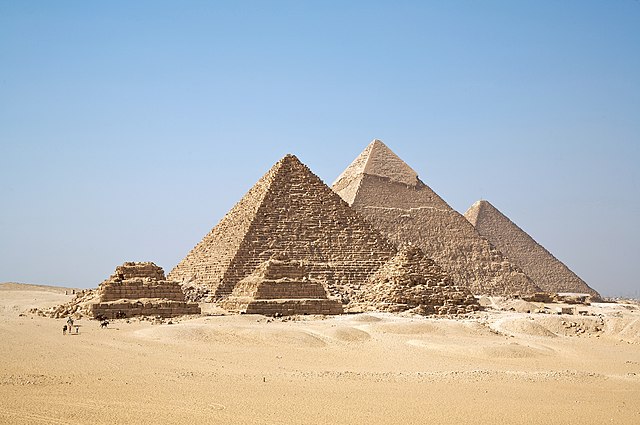
Ancient Egypt was a civilization of ancient North Africa, concentrated along the lower reaches of the Nile River, situated in the place that is now the country Egypt. Ancient Egyptian civilization followed prehistoric Egypt and coalesced around 3100 BC (according to conventional Egyptian chronology) with the political unification of Upper and Lower Egypt under Menes (often identified with Narmer). The history of ancient Egypt occurred as a series of stable kingdoms, separated by periods of relative instability known as Intermediate Periods: the Old Kingdom of the Early Bronze Age, the Middle Kingdom of the Middle Bronze Age and the New Kingdom of the Late Bronze Age.
Read More About Ancient Egypt / Source
Ancient Greece

Ancient Greece was a civilization belonging to a period of Greek history from the Greek Dark Ages of the 12th–9th centuries BC to the end of antiquity (c. AD 600). This era was immediately followed by the Early Middle Ages and the Byzantine period. Roughly three centuries after the Late Bronze Age collapse of Mycenaean Greece, Greek urban poleis began to form in the 8th century BC, ushering in the Archaic period and colonization of the Mediterranean Basin. This was followed by the age of Classical Greece, from the Greco-Persian Wars to the 5th to 4th centuries BC. The conquests of Alexander the Great of Macedon spread Hellenistic civilization from the western Mediterranean to Central Asia. The Hellenistic period ended with the conquest of the eastern Mediterranean world by the Roman Republic, and the annexation of the Roman province of Macedonia in Roman Greece, and later the province of Achaea during the Roman Empire.
Read More About Ancient Greece / Source
Anuradhapura
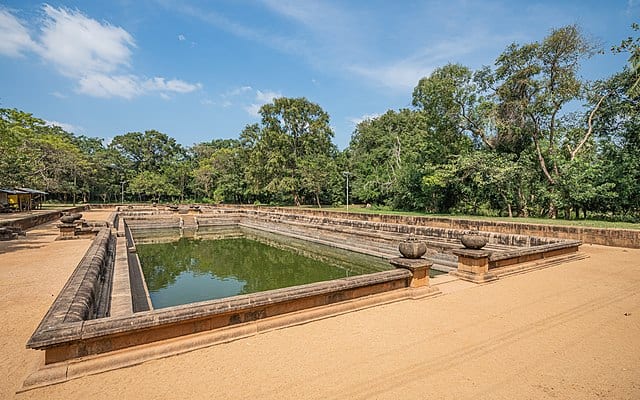
Anuradhapura is a major city in Sri Lanka. It is the capital city of North Central Province, Sri Lanka and the capital of Anuradhapura District. Anuradhapura is one of the ancient capitals of Sri Lanka, famous for its well-preserved ruins of an ancient Sinhala civilization. It was the third capital of the kingdom of Rajarata, following the kingdoms of Tambapanni and Upatissa Nuwara.
Read More About Anuradhapura / Source
Aurignacian
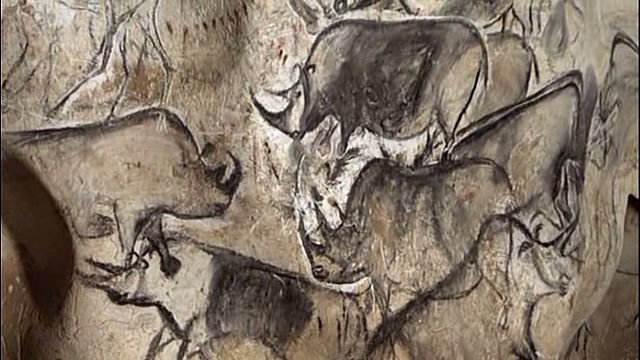
The Aurignacian is an archaeological tradition of the Upper Paleolithic associated with European early modern humans (EEMH) lasting from 43,000 to 26,000 years ago. The Upper Paleolithic developed in Europe some time after the Levant, where the Emiran period and the Ahmarian period form the first periods of the Upper Paleolithic, corresponding to the first stages of the expansion of Homo sapiens out of Africa. They then migrated to Europe and created the first European culture of modern humans, the Aurignacian.An Early Aurignacian or Proto-Aurignacian stage is dated between about 43,000 and 37,000 years ago. The Aurignacian proper lasts from about 37,000 to 33,000 years ago. A Late Aurignacian phase transitional with the Gravettian dates to about 33,000 to 26,000 years ago.
The type site is the Cave of Aurignac, Haute-Garonne, south-west France. The main preceding period is the Mousterian of the Neanderthals. One of the oldest examples of figurative art, the Venus of Hohle Fels, comes from the Aurignacian and is dated to between 40,000 and 35,000 years ago (though now earlier figurative art may be known, see Lubang Jeriji Saléh). It was discovered in September 2008 in a cave at Schelklingen in Baden-Württemberg in western Germany. The German Lion-man figure is given a similar date range.
Read More About Aurignacian / Source
Banpo culture
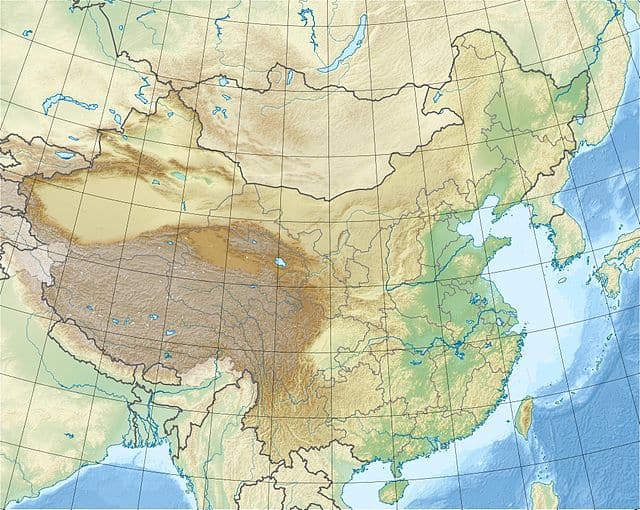
Banpo is an archaeological site discovered in 1953 and located in the Yellow River Valley just east of Xi’an, China. It contains the remains of several well organized Neolithic settlements, like Jiangzhai, carbon dated to 6700–5600 years ago. The area of 5 to 6 hectares (12 to 15 acres) is surrounded by a ditch, probably a defensive moat, 5 to 6 meters (16 to 20 ft) wide. The houses were circular, built of mud and wood with overhanging thatched roofs. They sat on low foundations. There appear to be communal burial areas.Banpo is the type site associated with Yangshao Culture. Archaeological sites with similarities to the first phase at Banpo are considered to be part of the “Banpo phase” (7th millennium BC) of the Yangshao culture. Banpo was excavated from 1954 to 1957.
The settlement was surrounded by a moat, with the graves and pottery kilns located outside the moat perimeter. Many of the houses were semisubterranean with the floor typically 1 meter (3 ft) below the ground surface. The houses were supported by timber poles and had steeply pitched thatched roofs.
According to the Marxist paradigm of archaeology that was prevalent in the China during the time of the excavation of the site, Banpo was considered to be a matriarchal society; however, new research contradicts this claim and the Marxist paradigm is gradually being phased out in modern Chinese archaeological research. Currently, little can be said of the religious or political structure from these ruins from the archaeological evidence.The site is now home to the Xi’an Banpo Museum, built in 1957 to preserve the archaeological collection.
Read More About Banpo culture / Source
Big-game hunting
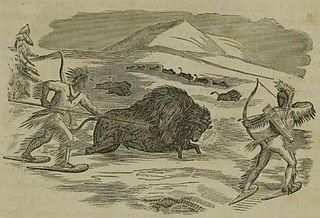
Big-game hunting is the hunting of large game animals for meat, commercially valuable by-products (such as horns, furs, tusks, bones, body fat/oil, or special organs and contents), trophy/taxidermy, or simply just for recreation (“sporting”). The term is often associated with the hunting of Africa’s “Big Five” games (lion, African elephant, Cape buffalo, African leopard, and rhinoceros), and with tigers and rhinoceroses on the Indian subcontinent. Many other species of big game are hunted including kudu, antelope, and hartebeest. Whale, moose, elk, caribou, bison, mule deer, brown bear and white-tailed deer are the largest game hunted in North America, where most big-game hunting is conducted today.
Big-game hunting is conducted in every continent except Antarctica, where the ecosystems provide habitats capable of supporting megafauna. In Africa, lion, Cape buffalo, elephant, giraffe and other large game animals are hunted, mainly for trophies. In North America, animals such as whale, bear, wolf, walrus, caribou, moose, elk, alligator, boar, sheep and bison are hunted. In South America, deer, cougar, feral pig, feral water buffalo, capybara and other species are hunted. In Europe, bear, sheep, boar, goats, elk (moose), bison, deer, and other species are hunted. In Asia, several species of deer, bear, sheep and other species are hunted. In Australia, kangaroos and several introduced species of deer (mainly red and sambar deer) and wild boar are hunted.
Read More About Big-game hunting / Source
Canaan
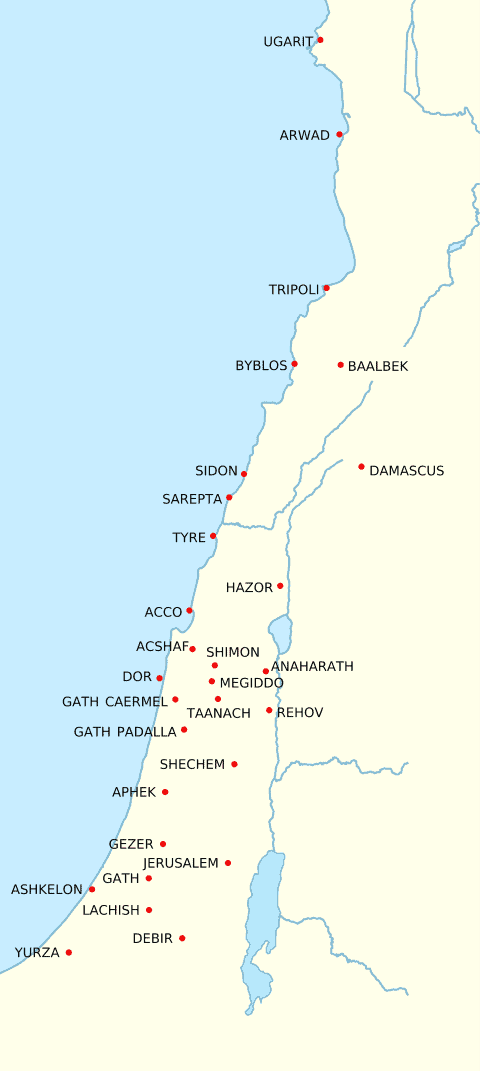
Canaan was a Semitic-speaking civilization and region in the Ancient Near East during the late 2nd millennium BC. The name “Canaan” appears throughout the Bible, where it corresponds to the Levant, in particular to the areas of the Southern Levant that provide the main setting of the narrative of the Bible: Phoenicia, Philistia, Israel, and other nations.
The word “Canaanites” serves as an ethnic catch-all term covering various indigenous populations—both settled and nomadic-pastoral groups—throughout the regions of the southern Levant or Canaan. It is by far the most frequently used ethnic term in the Bible. In the Book of Joshua, Canaanites are included in a list of nations to exterminate, and later described as a group which the Israelites had annihilated. Biblical scholar Mark Smith notes that archaeological data suggests “that the Israelite culture largely overlapped with and derived from Canaanite culture… In short, Israelite culture was largely Canaanite in nature.” The name “Canaanites” is attested, many centuries later, as the endonym of the people later known to the Ancient Greeks from c. 500 BC as Phoenicians, and after the emigration of Canaanite-speakers to Carthage (founded in the 9th century BC), was also used as a self-designation by the Punics (as “Chanani”) of North Africa during Late Antiquity.
Read More About Canaan / Source
Chavin culture

The Chavín culture is an extinct, pre-Columbian civilization, named for Chavín de Huantar, the principal archaeological site at which its artifacts have been found. The culture developed in the northern Andean highlands of Peru from 900 BCE to 200 BCE. It extended its influence to other civilizations along the coast. The Chavín people (whose name for themselves is unknown) were located in the Mosna Valley where the Mosna and Huachecsa rivers merge. This area is 3,150 metres (10,330 ft) above sea level and encompasses the quechua, suni, and puna life zones.
In the periodization of pre-Columbian Peru, the Chavín is the main culture of the Early Horizon period in highland Peru, characterized by the intensification of the religious cult, the appearance of ceramics closely related to the ceremonial centers, the improvement of agricultural techniques and the development of metallurgy and textiles. The best-known archaeological site for the Chavín culture is Chavín de Huantar, located in the Andean highlands of the present-day Ancash Region. It is believed to have been built around 900 BCE and was the religious and political center of the Chavín people. It has been designated a UNESCO World Heritage Site.
Read More About Chavin culture / Source
Danubian culture
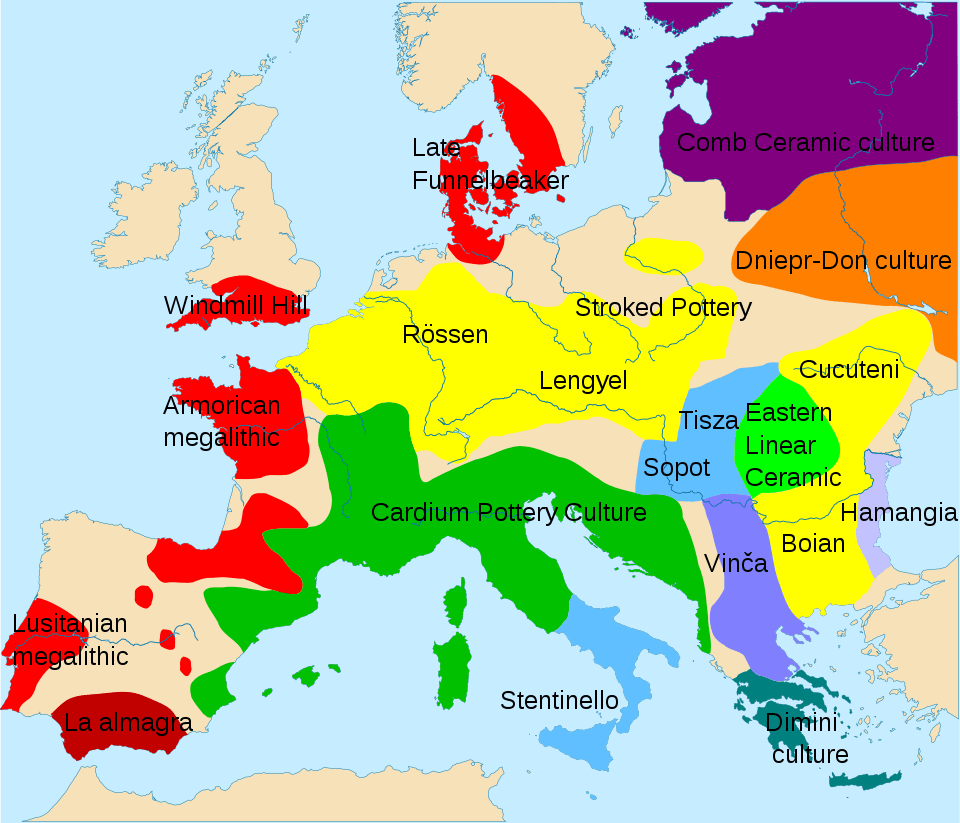
The term Danubian culture was coined by the Australian archaeologist Vere Gordon Childe to describe the first agrarian society in central and eastern Europe. It covers the Linear Pottery culture (Linearbandkeramik, LBK), stroked pottery and Rössen cultures. The beginning of the Linear Pottery culture dates to around 5500 BC. It appears to have spread westwards along the valley of the river Danube and interacted with the cultures of Atlantic Europe when they reached the Paris Basin.
Danubian I peoples cleared forests and cultivated fertile loess soils from the Balkans to the Low Countries and the Paris Basin. They made LBK pottery and kept domesticated cows, pigs, dogs, sheep and goats. The characteristic tool of the culture is the shoe-last celt, a kind of long thin stone adze which was used to fell trees and sometimes as a weapon, evidenced by the skulls found at Talheim, Neckar in Germany and Schletz in Austria. Settlements consisted of longhouses. According to a theory by Eduard Sangmeister, these settlements were abandoned, possibly as fertile land was exhausted, and then reoccupied perhaps when the land had lain fallow for long enough. In contrast, Peter Modderman and Jens Lüning believe the settlements were constantly inhabited, with individual families using specific plots (Hofplätze). They also imported spondylus shells from the Mediterranean.
Read More About Danubian culture / Source
Dong Son culture
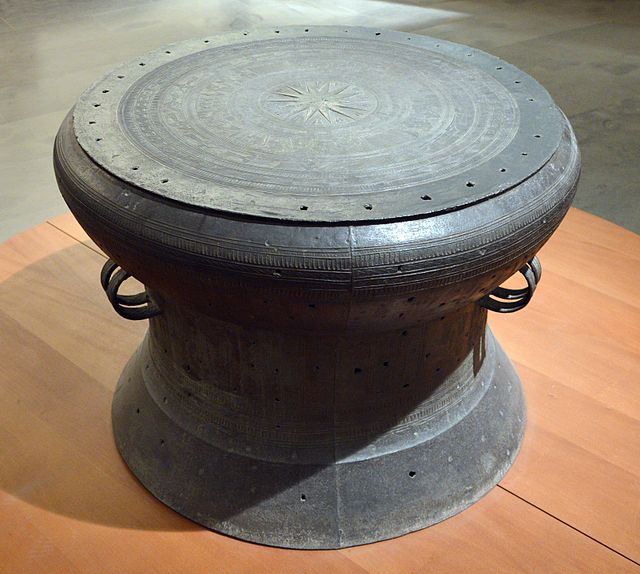
The Dong Son culture or the Lạc Việt culture (named for Đông Sơn, a village in Thanh Hóa, Vietnam) was a Bronze Age culture in ancient Vietnam centred at the Red River Valley of northern Vietnam from 1000 BC until the first century AD. Vietnamese historians attribute the culture to the states of Văn Lang and Âu Lạc. Its influence spread to other parts of Southeast Asia, including Maritime Southeast Asia, from about 1000 BC to 1 BC.The Dong Son people were skilled at cultivating rice, keeping water buffalos and pigs, fishing and sailing in long dugout canoes. They also were skilled bronze casters, which is evidenced by the Dong Son drum found widely throughout northern Vietnam and South China. To the south of the Dong Son culture was the Sa Huỳnh culture of the proto-Chams.
Read More About Dong Son culture / Source
Jomon period
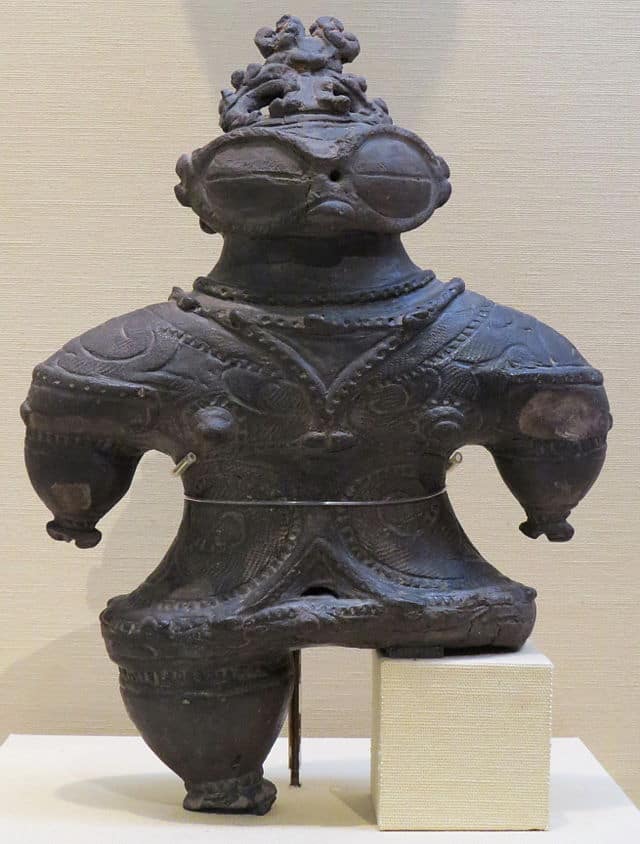
The Jōmon period is the time in Japanese prehistory, traditionally dated between c. 14,000–300 BCE, recently refined to about 1000 BCE, during which Japan was inhabited by a hunter-gatherer culture, which reached a considerable degree of sedentism and cultural complexity. The name “cord-marked” was first applied by the American zoologist and orientalist Edward S. Morse, who discovered sherds of pottery in 1877 and subsequently translated it into Japanese as Jōmon. The pottery style characteristic of the first phases of Jōmon culture was decorated by impressing cords into the surface of wet clay and is generally accepted to be among the oldest in the world.The Jōmon period was rich in tools and jewelry made from bone, stone, shell and antler; pottery figurines and vessels; and lacquerware. It is often compared to pre-Columbian cultures of the North American Pacific Northwest and especially to the Valdivia culture in Ecuador because in these settings cultural complexity developed within a primarily hunting-gathering context with limited use of horticulture.
Read More About Jomon period / Source
Magdalenian Culture
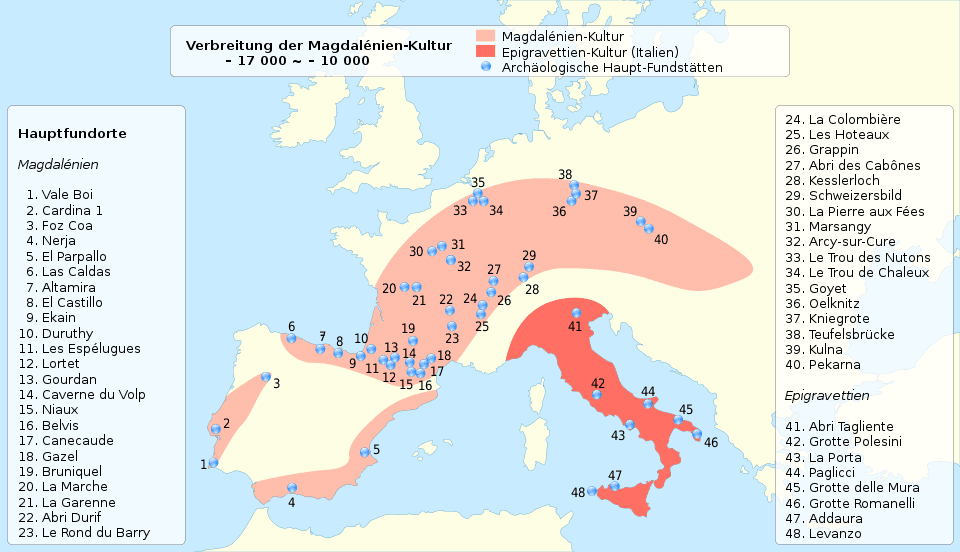
The Magdalenian cultures are later cultures of the Upper Paleolithic and Mesolithic in western Europe. They date from around 17,000 to 12,000 years ago. It is named after the type site of La Madeleine, a rock shelter located in the Vézère valley, commune of Tursac, in France’s Dordogne department. Édouard Lartet and Henry Christy originally termed the period L’âge du renne (the Age of the Reindeer). They conducted the first systematic excavators of the type site, publishing in 1875. The Magdalenian epoch is associated with reindeer hunters, although Magdalenian sites contain extensive evidence for the hunting of red deer, horses, and other large mammals present in Europe toward the end of the last glacial period. The culture was geographically widespread, and later Magdalenian sites stretched from Portugal in the west to Poland in the east, and as far north as France, the Channel Islands, England, and Wales. It is the third epoch of Gabriel de Mortillet’s cave chronology system, corresponding roughly to the Late Pleistocene.
Read More About Magdalenian Culture / Source
Mehrgarh Civilization
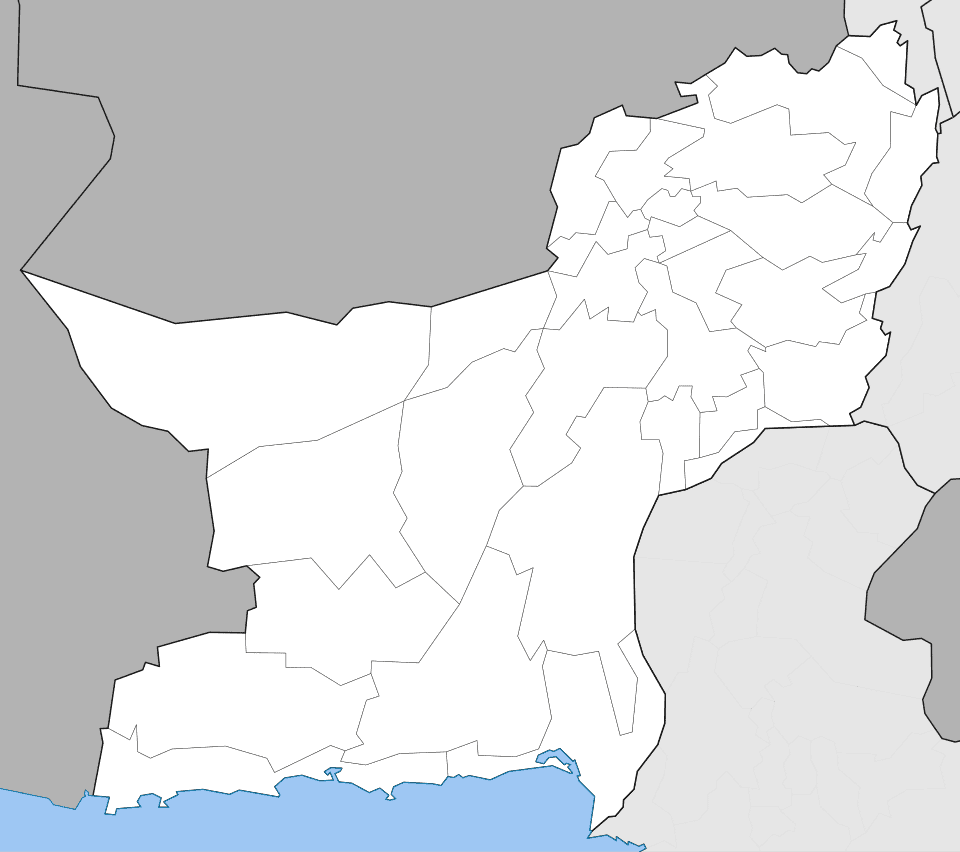
Mehrgarh is a Neolithic site (dated c. 7000 BCE to c. 2500/2000 BCE), which lies on the Kacchi Plain of Balochistan, Pakistan. Mehrgarh is located near the Bolan Pass, to the west of the Indus River valley and between the present-day Pakistani cities of Quetta, Kalat and Sibi. The site was discovered in 1974 by an archaeological team directed by French archaeologists Jean-François Jarrige and Catherine Jarrige, and was excavated continuously between 1974 and 1986, and again from 1997 to 2000. Archaeological material has been found in six mounds, and about 32,000 artifacts have been collected. The earliest settlement at Mehrgarh—in the northeast corner of the 495-acre (2.00 km2) site—was a small farming village dated between 7000 BCE and 5500 BCE.
Read More About Mehrgarh Civilization / Source
Mississippian culture
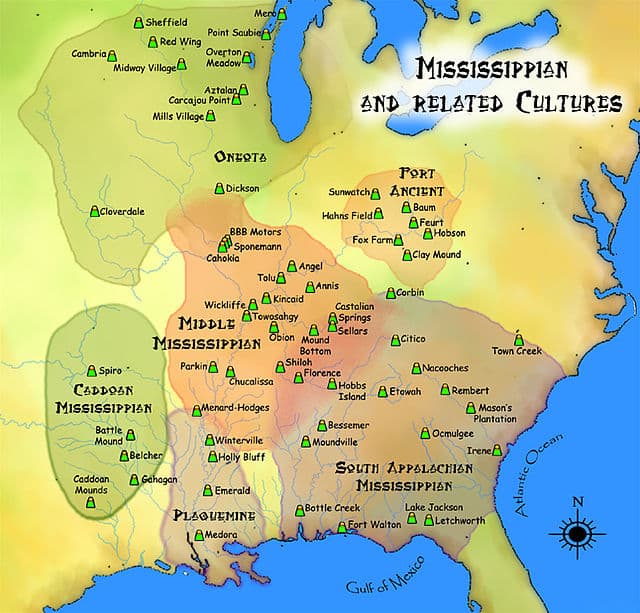
The Mississippian culture was a Native American civilization that flourished in what is now the Midwestern, Eastern, and Southeastern United States from approximately 800 CE to 1600 CE, varying regionally. It was known for building large, earthen platform mounds, and often other shaped mounds as well. It was composed of a series of urban settlements and satellite villages (suburbs) linked together by loose trading networks. The largest city was Cahokia, believed to be a major religious center located in what is present-day southern Illinois.
The Mississippian way of life began to develop in the Mississippi River Valley (for which it is named). Cultures in the tributary Tennessee River Valley may have also begun to develop Mississippian characteristics at this point. Almost all dated Mississippian sites predate 1539–1540 (when Hernando de Soto explored the area), with notable exceptions being Natchez communities. These maintained Mississippian cultural practices into the 18th century.
Read More About Mississippian culture / Source
Mogollon culture
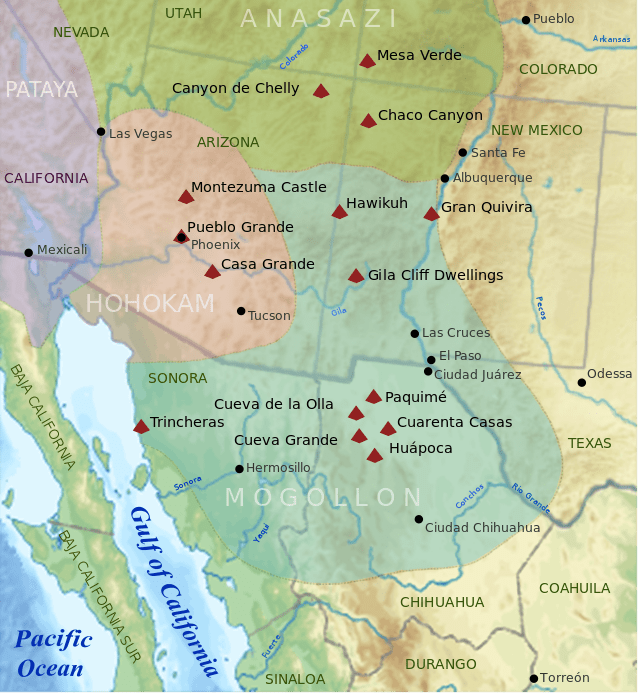
Mogollon culture is an archaeological culture of Native American peoples from Southern New Mexico and Arizona, Northern Sonora and Chihuahua, and Western Texas. The northern part of this region is Oasisamerica, while the southern span of the Mogollon culture is known as Aridoamerica.The Mogollon culture is one of the major prehistoric Southwestern cultural divisions of the Southwestern United States and Northern Mexico. The culture flourished from the archaic period, c. 200 CE, to either 1450 or 1540 CE, when the Spanish arrived.
Read More About Mogollon culture / Source
Natufian culture
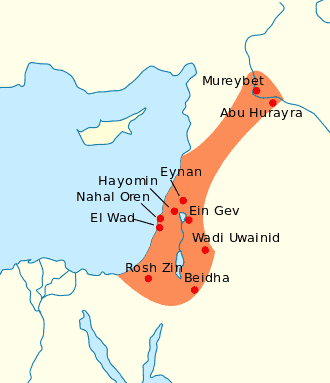
The Natufian culture is a Late Epipaleolithic archaeological culture of the Levant, dating to around 15,000 to 11,500 years ago. The culture was unusual in that it supported a sedentary or semi-sedentary population even before the introduction of agriculture. The Natufian communities may be the ancestors of the builders of the first Neolithic settlements of the region, which may have been the earliest in the world. Natufians founded a settlement where Jericho is today, which may therefore be the longest continuously inhabited urban area on Earth. Some evidence suggests deliberate cultivation of cereals, specifically rye, by the Natufian culture, at Tell Abu Hureyra, the site of earliest evidence of agriculture in the world. The world’s oldest evidence of bread-making has been found at Shubayqa 1, a 14,500-year-old site in Jordan’s northeastern desert. In addition, the oldest known evidence of beer, dating to approximately 13,000 BP, was found at the Raqefet Cave in Mount Carmel near Haifa in Israel.Generally, though, Natufians exploited wild cereals. Animals hunted included gazelles. According to Christy G. Turner II, there is archaeological and physical anthropological evidence for a relationship between the modern Semitic-speaking populations of the Levant and the Natufians.
Read More About Natufian culture / Source
Oldowan
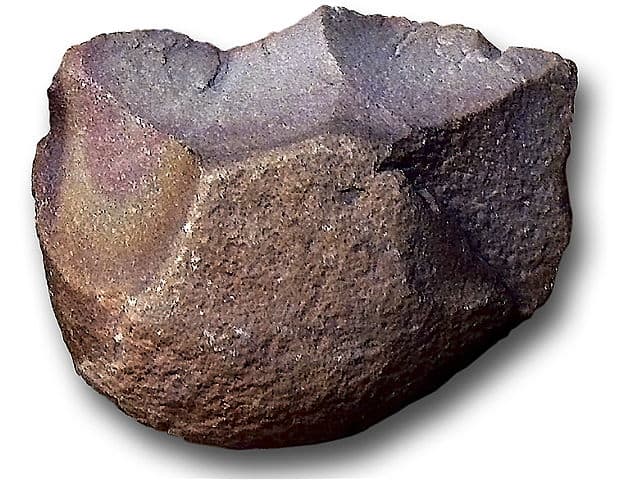
The Oldowan (or Mode I) was a widespread stone tool archaeological industry (style) in prehistory. These early tools were simple, usually made with one or a few flakes chipped off with another stone. Oldowan tools were used during the Lower Paleolithic period, 2.6 million years ago up until at least 1.7 million years ago, by ancient Hominins (early humans) across much of Africa, South Asia, the Middle East and Europe. This technological industry was followed by the more sophisticated Acheulean industry (two sites associated with Homo erectus at Gona in the Afar Region of Ethiopia dating from 1.5 and 1.26 million years ago have both Oldowan and Acheulean tools).
The term Oldowan is taken from the site of Olduvai Gorge in Tanzania, where the first Oldowan stone tools were discovered by the archaeologist Louis Leakey in the 1930s. However, some contemporary archaeologists and palaeoanthropologists prefer to use the term Mode 1 tools to designate pebble tool industries (including Oldowan), with Mode 2 designating bifacially worked tools (including Acheulean handaxes), Mode 3 designating prepared-core tools, and so forth.Classification of Oldowan tools is still somewhat contentious. Mary Leakey was the first to create a system to classify Oldowan assemblages, and built her system based on prescribed use. The system included choppers, scrapers, and pounders.
Read More About Oldowan / Source
Phoenicia
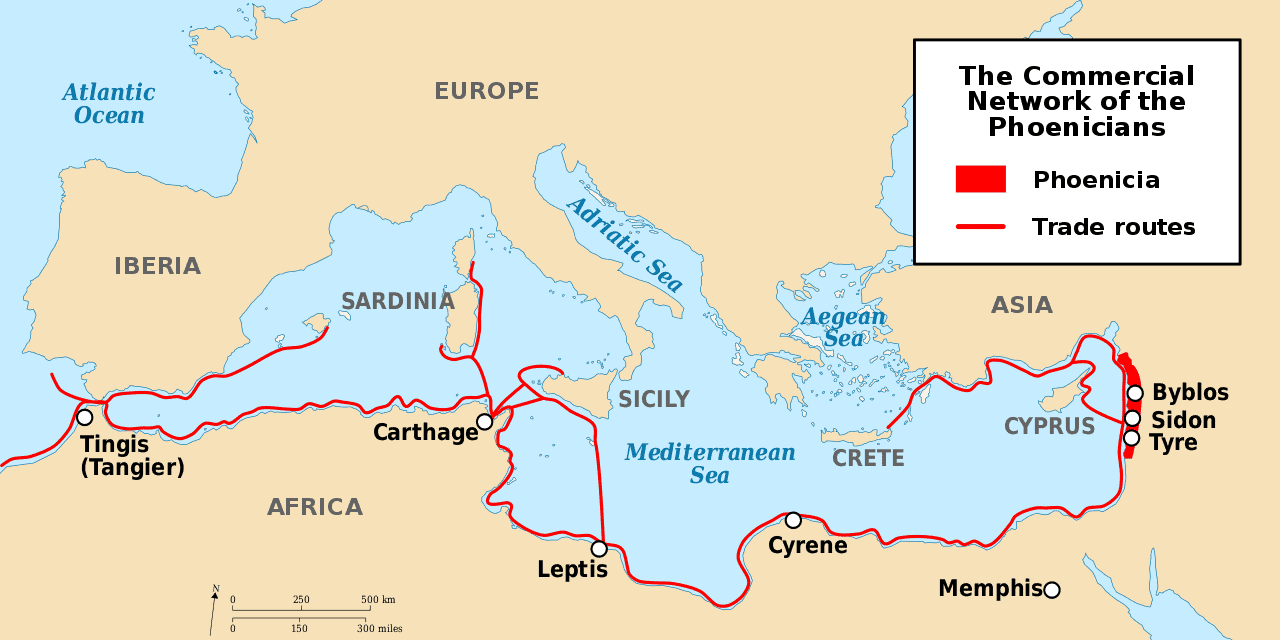
Phoenicia was an ancient Semitic-speaking thalassocratic civilization that originated in the Levant region of the eastern Mediterranean, primarily modern Lebanon. It was concentrated along the coast of Lebanon and included some coastal areas of modern Syria and Galilee, reaching as far north as Arwad and as far south as Acre and possibly Gaza. At its height between 1100 and 200 BC, Phoenician civilization spread across the Mediterranean, from the Levant to the Iberian Peninsula.
Read More About Phoenicia / Source
Aegean civilization
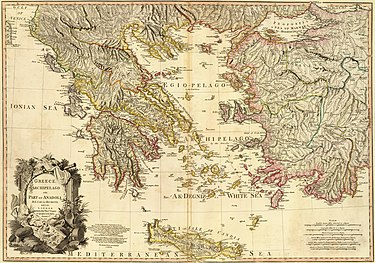
Aegean civilization is a general term for the Bronze Age civilizations of Greece around the Aegean Sea. There are three distinct but communicating and interacting geographic regions covered by this term: Crete, the Cyclades and the Greek mainland. Crete is associated with the Minoan civilization from the Early Bronze Age. The Cycladic civilization converges with the mainland during the Early Helladic (“Minyan”) period and with Crete in the Middle Minoan period. From c. 1450 BC (Late Helladic, Late Minoan), the Greek Mycenaean civilization spreads to Crete, probably by military conquest.
Read More About Aegean civilization / Source
African Pygmies
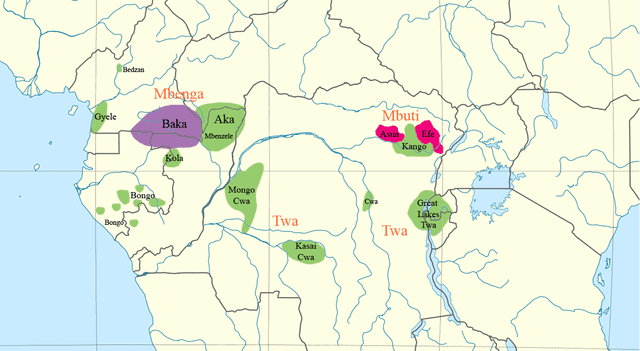
The African Pygmies (or Congo Pygmies, variously also “Central African foragers”, “African rainforest hunter-gatherers” (RHG) or “Forest People of Central Africa”) are a group of ethnicities native to Central Africa, mostly the Congo Basin, traditionally subsisting on a forager and hunter-gatherer lifestyle. They are divided into three roughly geographic groups: the western Bambenga, or Mbenga (Cameroon, Gabon, Republic of the Congo, Central African Republic),
the eastern Bambuti, or Mbuti, of the Congo basin (DRC)
the central and southern Batwa, or Twa (Rwanda, Burundi, DRC, Tanzania, Uganda, Zambia, Angola and Namibia). The more widely scattered (and more variable in physiology and lifestyle) Southern Twa are also grouped under the term Pygmoid.They are notable for, and named for, their short stature (described as “pygmyism” in anthropological literature). They are assumed to be descended from the original Middle Stone Age expansion of anatomically modern humans to Central Africa, albeit substantially affected by later migrations from West Africa, from their first appearance in the historical record in the 19th century limited to a comparative small area within Central Africa, greatly decimated by the prehistoric Bantu expansion, and to the present time widely affected by enslavement and cannibalism at the hands of neighboring Bantu groups.
Read More About African Pygmies / Source
Amorites
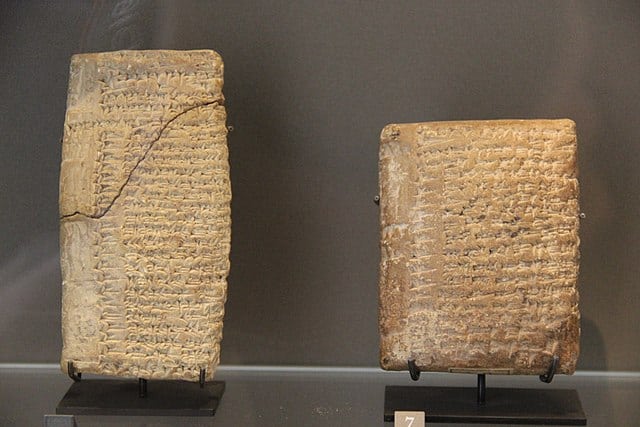
The Amorites were an ancient Northwest Semitic-speaking people from the Levant who also occupied large parts of southern Mesopotamia from the 21st century BC to the end of the 17th century BC, where they established several prominent city-states in existing locations, such as Isin, Larsa and later notably Babylon, which was raised from a small town to an independent state and a major city. The term Amurru in Akkadian and Sumerian texts refers to the Amorites, their principal deity and an Amorite kingdom. The Amorites are also mentioned in the Bible as inhabitants of Canaan both before and after the conquest of the land under Joshua.
Read More About Amorites / Source
Amratian culture
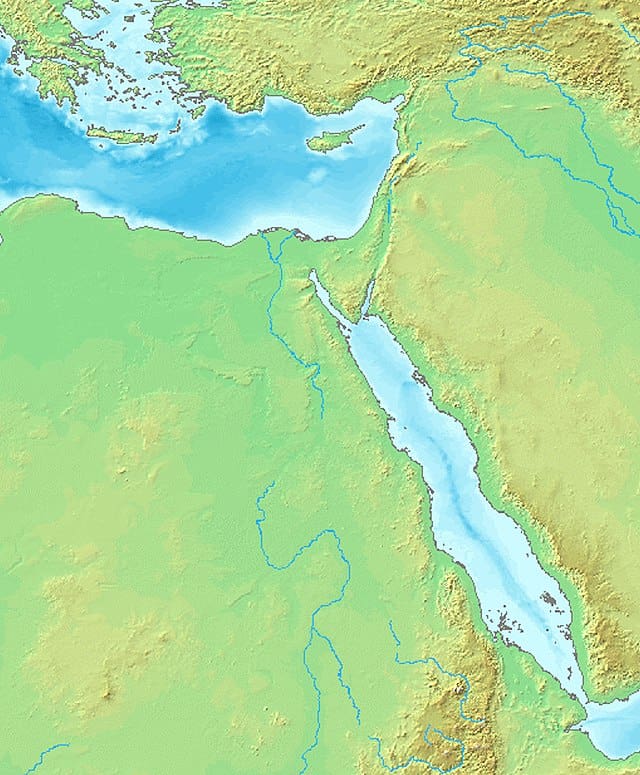
The Amratian culture, also called Naqada I, was a culture of prehistoric Upper Egypt. It lasted approximately from 4000 to 3500 BC. The Amratian culture is named after the archaeological site of el-Amra, located around 120 km (75 mi) south of Badari in Upper Egypt. El-Amra was the first site where this culture group was found without being mingled with the later Gerzeh culture (Naqada II). However, this period is better attested at the Nagada site, thus it also is referred to as the Naqada I culture.[3] Black-topped pottery continued to be produced, but white cross-line pottery, a type which has been decorated with close parallel white lines being crossed by another set of close parallel white lines, begins to be produced during this time. The Amratian falls between S.D. 30 and 39 in Flinders Petrie’s sequence dating system.
Read More About Amratian culture / Source
Ancestral Puebloans
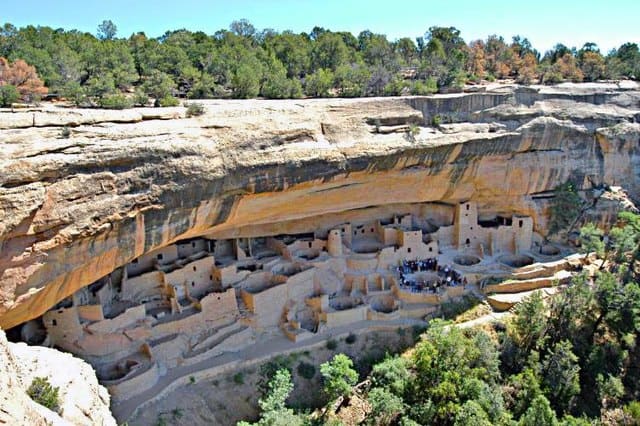
The Ancestral Puebloans were an ancient Native American culture that spanned the present-day Four Corners region of the United States, comprising southeastern Utah, northeastern Arizona, northwestern New Mexico, and southwestern Colorado. The Ancestral Puebloans are believed to have developed, at least in part, from the Oshara Tradition, who developed from the Picosa culture.
They lived in a range of structures that included small family pit houses, larger structures to house clans, grand pueblos, and cliff-sited dwellings for defense. The Ancestral Puebloans possessed a complex network that stretched across the Colorado Plateau linking hundreds of communities and population centers. They held a distinct knowledge of celestial sciences that found form in their architecture. The kiva, a congregational space that was used chiefly for ceremonial purposes, was an integral part of this ancient people’s community structure.
Read More About Ancestral Puebloans / Source
Ancient Iran
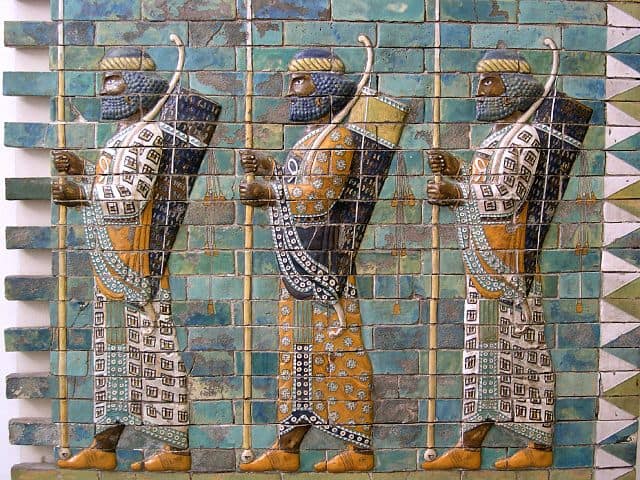
Iran is home to one of the world’s oldest continuous major civilizations, with historical and urban settlements dating back to 7000 BC. The south-western and western part of the Iranian Plateau participated in the traditional Ancient Near East with Elam, from the Early Bronze Age, and later with various other peoples, such as the Kassites, Mannaeans, and Gutians. Georg Wilhelm Friedrich Hegel calls the Persians the “first Historical People”. The Medes unified Iran as a nation and empire in 625 BC.
Read More About Ancient Iran / Source
Ancient Italic People
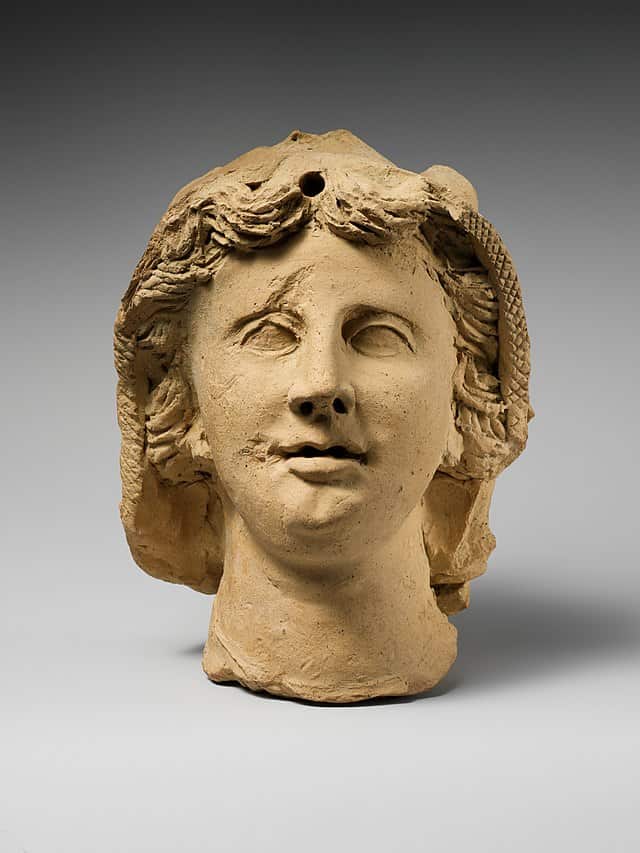
This list of ancient peoples living in Italy summarises groupings existing before the Roman expansion and conquest. Many of the names are either scholarly inventions or exonyms assigned by the ancient writers of works in ancient Greek and Latin. In regard to the specific names of particular ancient Italian tribes and peoples, the time-window in which historians know the historical ascribed names of ancient Italian peoples mostly falls into the range of about 750 BC (at the legendary foundation of Rome) to about 200 BC (in the middle Roman Republic), the time range in which most of the written documentation first exists of such names and prior to the nearly complete assimilation of Italian peoples into Roman culture. Nearly all of these peoples and tribes spoke Indo-European languages: Italics, Celts, Ancient Greeks, and tribes likely occupying various intermediate positions between these language groups. On the other hand, some Italian peoples (such as the Rhaetians, Camuni, Etruscans) likely spoke non-Indo-European languages. Peoples speaking languages of the Afro-Asiatic family are known to have settled in some coastal parts of insular Italy, Sardinia and western Sicily, specifically the Semitic Phoenicians and Carthaginians.
Read More About Ancient Italic People / Source
Ancient Middle East
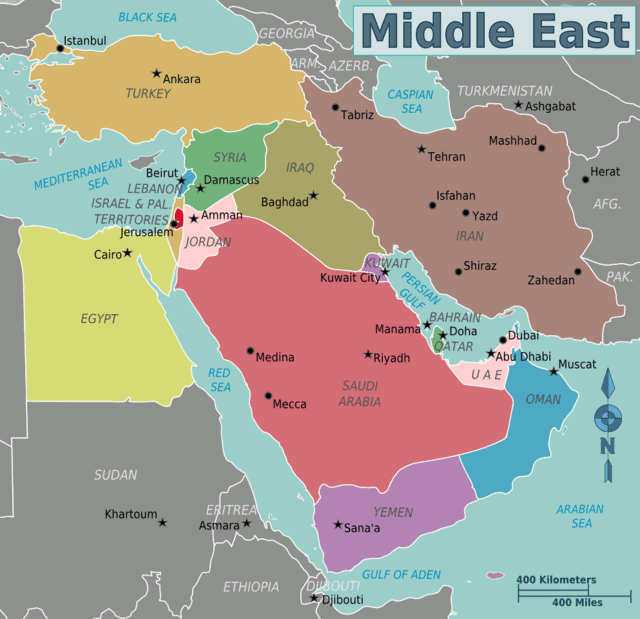
Home to the Cradle of Civilization, the Middle East—interchangeable with the Near East—has seen many of the world’s oldest cultures and civilizations. This history started from the earliest human settlements, continuing through several major pre- and post-Islamic Empires through to the nation-states of the Middle East today. Part of a series on Human history Human Era ↑ Prehistory (Pleistocene epoch) Holocene Timelines Neolithic – Contemporary (10,000 BCE – 2021 CE) Age of the human raceRecorded history Earliest recordsProtohistoryProto-writing Ancient Bronze ageIron age Axial antiquityClassical antiquityLate antiquity AfricaNorth AmericaSouth America OceaniaEast AsiaSouth Asia Southeast AsiaWest Asia Europe Postclassical AfricaAmericas OceaniaEast Asia South Asia Southeast AsiaWest Asia Europe Modern Early modernLate modern AfricaNorth AmericaSouth America OceaniaEast AsiaSouth Asia Southeast AsiaWest Asia Europe See also ModernityFuturology ↓ Future vte Sumerians were the first people to develop complex systems as to be called “Civilization”, starting as far back as the 5th millennium BC. Egyptian civilization coalesced around 3150 BC with the political unification of Upper and Lower Egypt under the first pharaoh.
Read More About Ancient Middle East / Source
Ancient Rome
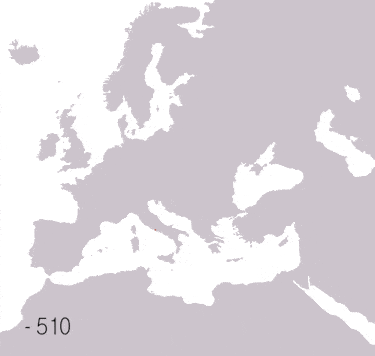
In historiography, ancient Rome is Roman civilization from the founding of the Italian city of Rome in the 8th century BC to the collapse of the Western Roman Empire in the 5th century AD, encompassing the Roman Kingdom (753 BC–509 BC), Roman Republic (509 BC–27 BC) and Roman Empire (27 BC–476 AD) until the fall of the western empire. The civilisation began as an Italic settlement in the Italian Peninsula, traditionally dated to 753 BC, that grew into the city of Rome and which subsequently gave its name to the empire over which it ruled and to the widespread civilisation the empire developed. The civilization was led and ruled by the Romans, alternately considered an ethnic group or a nationality. The Roman Empire expanded to become one of the largest empires in the ancient world, still ruled from the city, with an estimated 50 to 90 million inhabitants (roughly 20% of the world’s population at the time) and covering 5 million square kilometres (1.9 million square miles) at its height in AD 117.
Read More About Ancient Rome / Source
Andean civilizations
The Andean civilizations were complex societies of many cultures and peoples mainly developed in the river valleys of the coastal deserts of Peru. They stretched from the Andes of southern Colombia southward down the Andes to Chile and northwest Argentina. Archaeologists believe that Andean civilizations first developed on the narrow coastal plain of the Pacific Ocean. The Caral or Norte Chico civilization of Peru is the oldest known civilization in the Americas, dating back to 3200 BCE.
Read More About Andean civilizations / Source
Archaic period
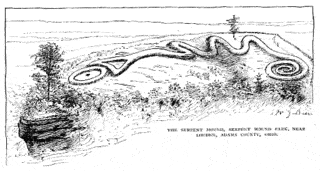
In the classification of the archaeological cultures of North America, the Archaic period in North America, taken to last from around 8000 to 1000 BC in the sequence of North American pre-Columbian cultural stages, is a period defined by the archaic stage of cultural development.
The Archaic stage is characterized by subsistence economies supported through the exploitation of nuts, seeds, and shellfish. As its ending is defined by the adoption of sedentary farming, this date can vary significantly across the Americas. The rest of the Americas also have an Archaic Period.
Read More About Archaic period / Source
Aterian
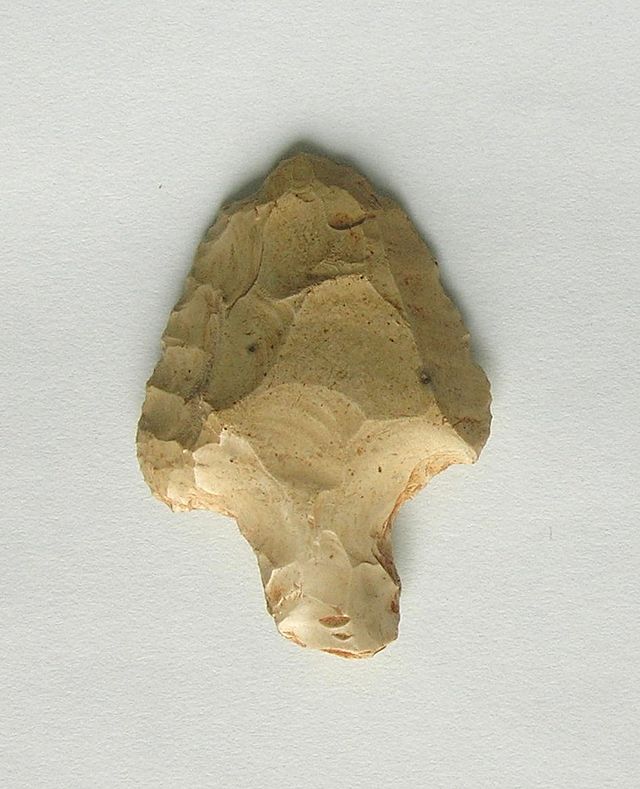
The Aterian is a Middle Stone Age (or Middle Palaeolithic) stone tool industry centered in North Africa, but also possibly found in Oman, the Thar Desert, Sahara (Saharan Aterian) and northeast Africa (Eastern Aterian). The earliest Aterian dates to c. 150,000 years ago, at the site of Ifri n’Ammar in Morocco. However, most of the early dates cluster around the beginning of the Last Interglacial, around 150,000 to 130,000 years ago, when the environment of North Africa began to ameliorate. The Aterian disappeared around 20,000 years ago.
The Aterian is primarily distinguished through the presence of tanged or pedunculated tools, and is named after the type site of Bir el Ater, south of Tébessa. Bifacially-worked, leaf-shaped tools are also a common artefact type in Aterian assemblages, and so are racloirs and Levallois flakes and cores. Items of personal adornment (pierced and ochred Nassarius shell beads) are known from at least one Aterian site, with an age of 82,000 years. The Aterian is one of the oldest examples of regional technological diversification, evidencing significant differentiation to older stone tool industries in the area, frequently described as Mousterian. The appropriateness of the term Mousterian is contested in a North African context, however.
Read More About Aterian / Source
Azilian
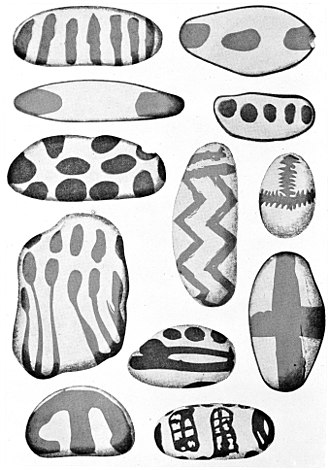
The Azilian is a name given by archaeologists to an industry in the Franco-Cantabrian region of northern Spain and southern France. It dates approximately 10,000–12,500 years ago. Diagnostic artifacts from the culture include Azilian points (microliths with rounded retouched backs), crude flat bone harpoons and pebbles with abstract decoration. The latter were first found in the River Arize at the type-site for the culture, the Grotte du Mas d’Azil at Le Mas-d’Azil in the French Pyrenees (illustrated, now with a modern road running through it). These are the main type of Azilian art, showing a great reduction in scale and complexity from the Magdalenian Art of the Upper Palaeolithic.The industry can be classified as part of the Epipaleolithic or the Mesolithic periods, or of both. Archaeologists think the Azilian represents the tail end of the Magdalenian as the warming climate brought about changes in human behaviour in the area. The effects of melting ice sheets would have diminished the food supply and probably impoverished the previously well-fed Magdalenian manufacturers, or at least those who had not followed the herds of horse and reindeer out of the glacial refugium to new territory. As a result, Azilian tools and art were cruder and less expansive than their Ice Age predecessors – or simply different.
Read More About Azilian / Source
Boian culture
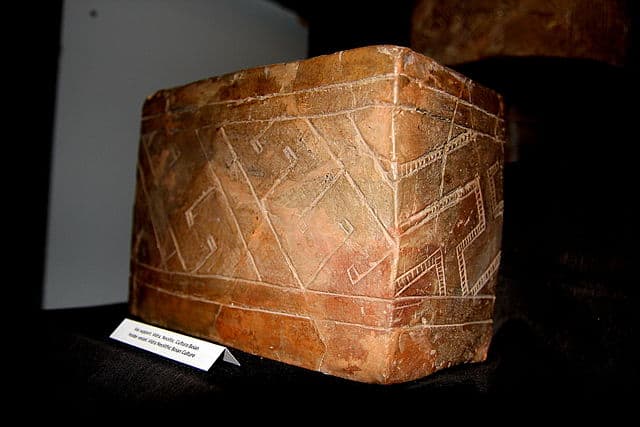
The Boian culture (dated to 4300–3500 BC), also known as the Giuleşti–Mariţa culture or Mariţa culture, is a Neolithic archaeological culture of Southeast Europe. It is primarily found along the lower course of the Danube in what is now Romania and Bulgaria, and thus may be considered a Danubian culture.
Read More About Boian culture / Source
Capsian culture
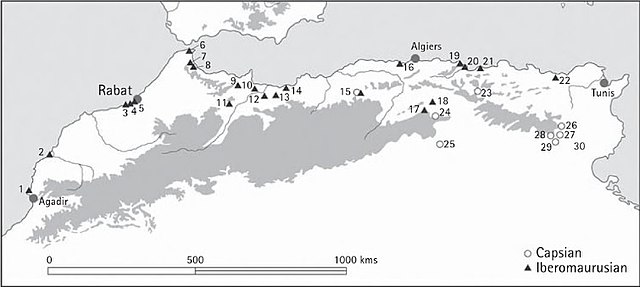
The Capsian culture was a Mesolithic and Neolithic culture centered in the Maghreb that lasted from about 8,000 to 2,700 BC. It was named after the town of Gafsa in Tunisia, which was known as Capsa in Roman times.
The Capsian industry was concentrated mainly in modern Tunisia and Algeria, with some lithic sites attested from southern Spain to Sicily. It is traditionally divided into two horizons, the Capsien typique (Typical Capsian) and the Capsien supérieur (Upper Capsian), which are sometimes found in chronostratigraphic sequence. Sometimes, a third period, Capsian Neolithic (6,200-5,300 BP) is also specified. They represent variants of one tradition, the differences between them being both typological and technological.During this period, the environment of the Maghreb was open savanna, much like modern East Africa, with Mediterranean forests at higher altitudes. The Capsian diet included a wide variety of animals, ranging from aurochs and hartebeest to hares and snails; there is little evidence concerning plants eaten. During the succeeding Neolithic of Capsian Tradition, there is evidence from one site, for domesticated, probably imported, ovicaprids.Anatomically, Capsian populations were modern Homo sapiens, traditionally classed into two variegate types: Proto-Mediterranean and Mechta-Afalou on the basis of cranial morphology. Some have argued that they were immigrants from the east (Natufians), whereas others argue for population continuity based on physical skeletal characteristics and other criteria.Given the Capsian culture’s timescale, widespread occurrence in the Sahara, and geographic association with modern speakers of the Afroasiatic languages, historical linguists have tentatively associated the industry with the Afroasiatic family’s earliest speakers on the continent.Nothing is known about Capsian religion, but their burial methods suggest a belief in an afterlife. Decorative art is widely found at their sites, including figurative and abstract rock art, and ochre is found coloring both tools and corpses. Ostrich eggshells were used to make beads and containers; seashells were used for necklaces. The Ibero-Maurusian practice of extracting the central incisors continued sporadically, but became rarer.
The Eburran industry which dates between 13,000 and 9,000 BC in East Africa, was formerly known as the “Kenya Capsian” due to similarities in the stone blade shapes.
Read More About Capsian culture / Source
Carthage

Carthage was an ancient Phoenician city-state and civilization located in present-day Tunisia. Founded around 814 BC as a colony of Tyre, it was one of the richest and most powerful cities in antiquity, and the center of a major commercial and maritime empire that dominated the western Mediterranean until the mid third century BC.After gaining independence in the seventh century BC, Carthage gradually expanded its economic and political hegemony across northwest Africa, Iberia, and the major islands of the western Mediterranean. By 300 BC, the Carthaginian Empire spanned a patchwork of colonies, vassals, and satellite states that constituted more territory than any other polity in the region. Carthage’s wealth and power rested primarily on its strategic location, which provided access to abundant fertile land and major trade routes. Its vast mercantile network, which extended as far as west Africa and northern Europe, provided an array of commodities from all over the ancient world, as well as lucrative exports of agricultural goods and manufactured products.
Read More About Carthage / Source
Clactonian
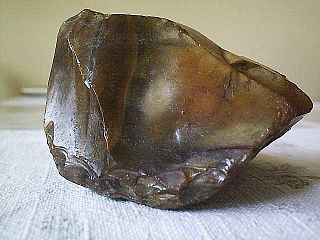
The Clactonian is the name given by archaeologists to an industry of European flint tool manufacture that dates to the early part of the interglacial period known as the Hoxnian, the Mindel-Riss or the Holstein stages (c. 400,000 years ago). Clactonian tools were made by Homo heidelbergensis.It is named after 400,000-year-old finds made by Hazzledine Warren in a palaeochannel at Clacton-on-Sea in the English county of Essex in 1911. The artifacts found there included flint chopping tools, flint flakes and the tip of a worked wooden shaft along with the remains of a giant elephant and hippopotamus. Further examples of the tools have been found at sites including Barnfield Pit and Rickson’s Pit, near Swanscombe in Kent and Barnham in Suffolk; similar industries have been identified across Northern Europe. The Clactonian industry involved striking thick, irregular flakes from a core of flint, which was then employed as a chopper. The flakes would have been used as crude knives or scrapers. Unlike the Oldowan tools from which Clactonian ones derived, some were notched implying that they were attached to a handle or shaft. Retouch is uncommon and the prominent bulb of percussion on the flakes indicates use of a hammerstone.
Read More About Clactonian / Source
Clovis culture
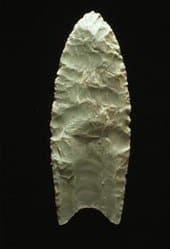
The Clovis culture is a prehistoric Paleoamerican culture, named for distinct stone tools found in close association with Pleistocene fauna at Blackwater Locality No. 1 near Clovis, New Mexico in the 1920s and 1930s. It appears around 11,500–11,000 uncalibrated RCYBP at the end of the last glacial period, and is characterized by the manufacture of “Clovis points” and distinctive bone and ivory tools. Archaeologists’ most precise determinations at present suggest this radiocarbon age is equal to roughly 13,200 to 12,900 calendar years ago. Clovis people are considered to be the ancestors of most of the indigenous peoples of the Americas.The only human burial that has been directly associated with tools from the Clovis culture included the remains of an infant boy researchers named Anzick-1. Paleogenetic analyses of Anzick-1’s ancient nuclear, mitochondrial, and Y-chromosome DNA reveal that Anzick-1 is closely related to modern Native American populations, which lends support to the Beringia hypothesis for the settlement of the Americas.The Clovis culture was replaced by several more localized regional societies from the Younger Dryas cold-climate period onward. Post-Clovis cultures include the Folsom tradition, Gainey, Suwannee-Simpson, Plainview-Goshen, Cumberland, and Redstone. Each of these is thought to derive directly from Clovis, in some cases apparently differing only in the length of the fluting on their projectile points.
Read More About Clovis culture / Source
Cucuteni–Trypillia culture

The Cucuteni–Trypillia culture (Romanian: Cultura Cucuteni and Ukrainian: Трипільська культура), also known as the Tripolye culture (Russian: Трипольская культура), is a Neolithic–Eneolithic archaeological culture (c. 5500 to 2750 BCE) of Eastern Europe. It extended from the Carpathian Mountains to the Dniester and Dnieper regions, centred on modern-day Moldova and covering substantial parts of western Ukraine and northeastern Romania, encompassing an area of 350,000 km2 (140,000 sq mi), with a diameter of 500 km (300 mi; roughly from Kyiv in the northeast to Brașov in the southwest).The majority of Cucuteni–Trypillia settlements consisted of high-density, small settlements (spaced 3 to 4 kilometres apart), concentrated mainly in the Siret, Prut and Dniester river valleys.During the Middle Trypillia phase (c. 4000 to 3500 BCE), populations belonging to the Cucuteni–Trypillia culture built the largest settlements in Neolithic Europe, some of which contained as many as three thousand structures and were possibly inhabited by 20,000 to 46,000 people.One of the most notable aspects of this culture was the periodic destruction of settlements, with each single-habitation site having a lifetime of roughly 60 to 80 years. The purpose of burning these settlements is a subject of debate among scholars; some of the settlements were reconstructed several times on top of earlier habitational levels, preserving the shape and the orientation of the older buildings. One particular location; the Poduri site in Romania, revealed thirteen habitation levels that were constructed on top of each other over many years.
Read More About Cucuteni–Trypillia culture / Source
Cycladic culture
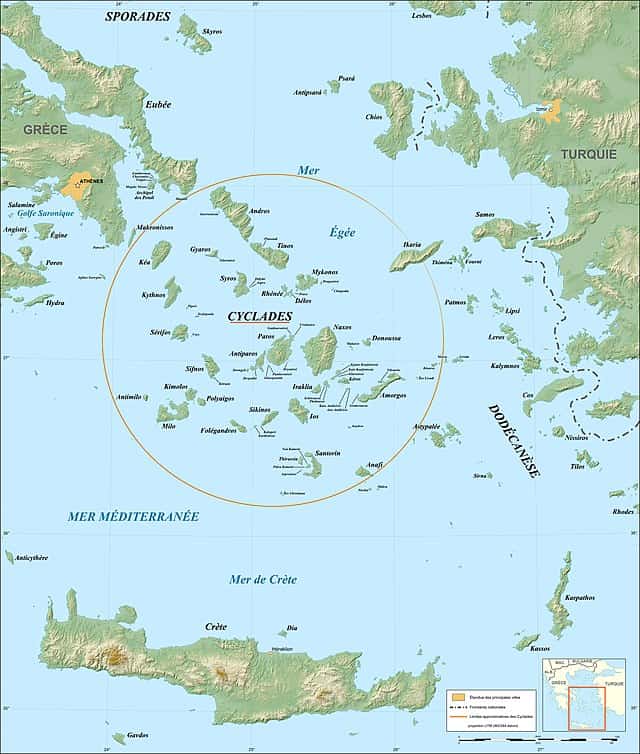
Cycladic culture (also known as Cycladic civilisation or, chronologically, as Cycladic chronology) was a Bronze Age culture (c. 3200–c. 1050 BC) found throughout the islands of the Cyclades in the Aegean Sea. In chronological terms, it is a relative dating system for artefacts which broadly complements Helladic chronology (mainland Greece) and Minoan chronology (Crete) during the same period of time.
Read More About Cycladic culture / Source
Dawenkou culture
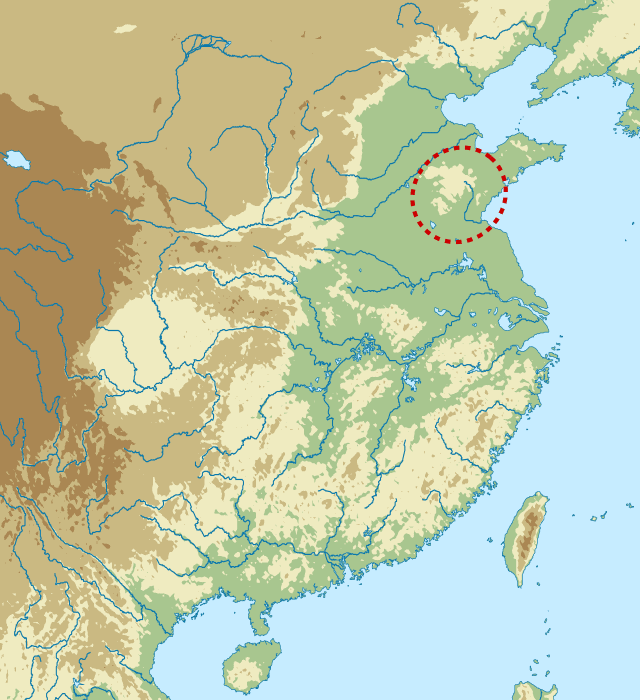
The Dawenkou culture is a name given by archaeologists to a group of Neolithic communities who lived primarily in Shandong, but also appeared in Anhui, Henan and Jiangsu, China. The culture existed from 4100 to 2600 BC, co-existing with the Yangshao culture. Turquoise, jade and ivory artefacts are commonly found at Dawenkou sites. The earliest examples of alligator drums appear at Dawenkou sites. Neolithic signs, perhaps related to subsequent scripts, such as those of the Shang Dynasty, have been found on Dawenkou pottery.Archaeologists commonly divide the culture into three phases: the early phase (4100–3500 BC), the middle phase (3500–3000 BC) and the late phase (3000–2600 BC). Based on the evidence from grave goods, the early phase was highly egalitarian. The phase is typified by the presence of individually designed, long-stemmed cups (鬹 guī). Graves built with earthen ledges became increasingly common during the latter parts of the early phase. During the middle phase, grave goods began to emphasize quantity over diversity. During the late phase, wooden coffins began to appear in Dawenkou burials. The culture became increasingly stratified, as some graves contained no grave goods while others contained a large quantity of grave goods.
Read More About Dawenkou culture / Source
Dorset culture
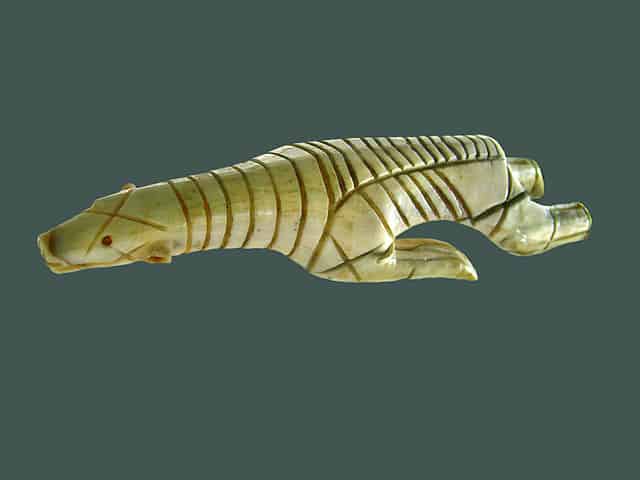
The Dorset was a Paleo-Eskimo culture, lasting from 500 BC to between AD 1000 and 1500, that followed the Pre-Dorset and preceded the Inuit in the Arctic of North America. It is named after Cape Dorset in Nunavut, Canada, where the first evidence of its existence was found. The culture has been defined as having four phases due to the distinct differences in the technologies relating to hunting and tool making. Artifacts include distinctive triangular end-blades, soapstone lamps, and burins.
The Dorset were first identified as a separate culture in 1925. The Dorset appear to have been extinct by 1500 at the latest and perhaps as early as 1000. The Thule people, who began migrating east from Alaska in the 11th century, ended up spreading through the lands previously inhabited by the Dorset. There is no strong evidence that the Inuit and Dorset ever met. Modern genetic studies show the Dorset population were distinct from later groups and that “[t]here was virtually no evidence of genetic or cultural interaction between the Dorset and the Thule peoples.”Inuit legends recount them encountering people they called the Tuniit (singular Tuniq) or Sivullirmiut “First Inhabitants”. According to legend, the first Inhabitants were giants, taller and stronger than the Inuit but afraid to interact and “easily put to flight.”
Read More About Dorset culture / Source
Dwarka
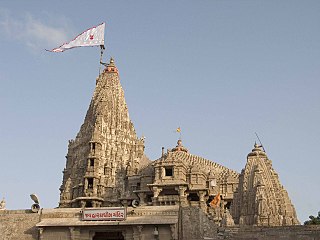
Dwarka is a city and a municipality of Devbhumi Dwarka district in the state of Gujarat in northwestern India. It is located on the western shore of the Okhamandal Peninsula on the right bank of the Gomti River. In 2011 it had a population of 38,873. Dwarka is one of the Chardhams, four sacred Hindu pilgrimage sites, and is one of the Sapta Puri, the seven most ancient religious cities in the country. Dwarka is often identified with the Dwarka Kingdom, the ancient kingdom of Krishna, and is believed to have been the first capital of Gujarat.
Read More About Dwarka / Source
El Argar
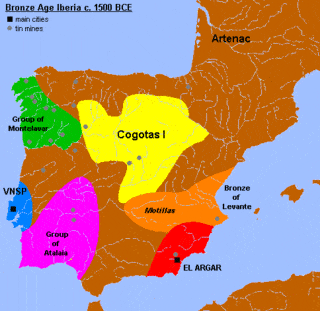
El Argar is an Early Bronze Age culture that was based in Antas, Almería, within modern Spain. It is believed to have been active from about 2200 B.C. to 1500 B.C. The people developed sophisticated pottery and ceramic techniques, which they traded with other Mediterranean tribes.The civilization of El Argar extended to all the province of Almería, north onto the central Meseta, to most of the region of Murcia and westwards into the provinces of Granada and Jaen, controlling an area similar in size to modern Belgium.Its cultural and possibly political influence was much wider. Its influence has been found in eastern and southwestern Iberia (Algarve), and it likely affected other regions as well. Some authors have suggested that El Argar was a unified state.
Read More About El Argar / Source
Elam
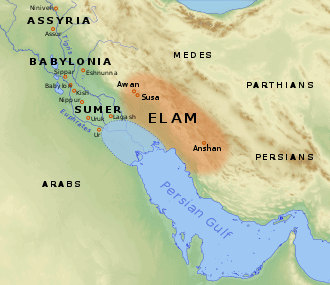
Elam was an ancient civilization centered in the far west and southwest of modern-day Iran, stretching from the lowlands of what is now Khuzestan and Ilam Province as well as a small part of southern Iraq. The modern name Elam stems from the Sumerian transliteration elam, along with the later Akkadian elamtu, and the Elamite haltamti. Elamite states were among the leading political forces of the Ancient Near East.In classical literature, Elam was also known as Susiana, a name derived from its capital Susa.
Erlitou culture
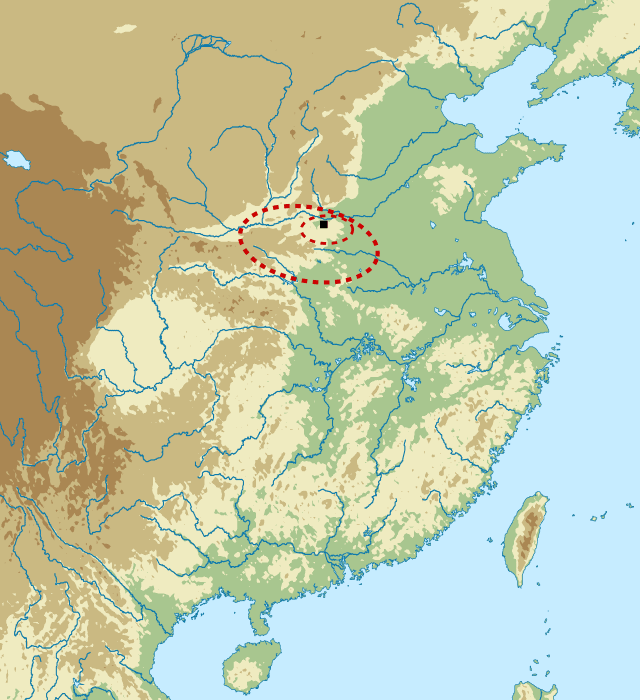
The Erlitou culture was an early Bronze Age urban society and archaeological culture that existed in the Yellow River valley from approximately 1900 to 1500 BC. A 2007 study of radiocarbon dating proposed a narrower date range of 1750 to 1530 BC. The culture was named after the site discovered at Erlitou in Yanshi, Henan. The culture was widely spread throughout Henan and Shanxi and later appeared in Shaanxi and Hubei. Chinese archaeologists generally identify the Erlitou culture as the site of the Xia dynasty, but there is no firm evidence, such as writing, to substantiate such a linkage.
Read More About Erlitou culture / Source
Ertebølle culture
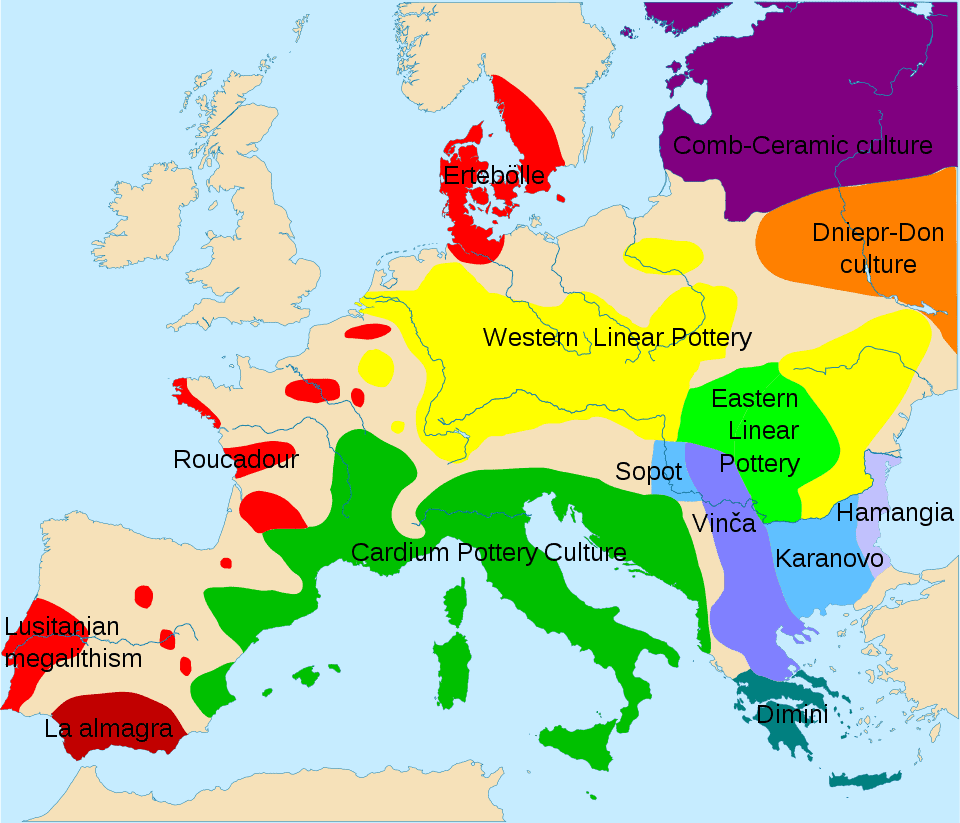
The Ertebølle culture (ca 5300 BC – 3950 BC) is the name of a hunter-gatherer and fisher, pottery-making culture dating to the end of the Mesolithic period. The culture was concentrated in Southern Scandinavia, but genetically linked to strongly related cultures in Northern Germany and the Northern Netherlands. It is named after the type site, a location in the small village of Ertebølle on Limfjorden in Danish Jutland. In the 1890s, the National Museum of Denmark excavated heaps of oyster shells there, mixed with mussels, snails, bones and bone, antler and flint artifacts, which were evaluated as kitchen middens (Danish køkkenmødding), or refuse dumps. Accordingly, the culture is less commonly named the Kitchen Midden. As it is approximately identical to the Ellerbek culture of Schleswig-Holstein, the combined name, Ertebølle-Ellerbek is often used. The Ellerbek culture (German Ellerbek Kultur) is named after a type site in Ellerbek, a community on the edge of Kiel, Germany.
In the 1960s and 1970s another closely related culture was found in the (now dry) Noordoostpolder in the Netherlands, near the village Swifterbant and the former island of Urk. Named the Swifterbant culture (5300 – 3400 BC) they show a transition from hunter-gatherer to both animal husbandry, primarily cows and pigs, and cultivation of barley and emmer wheat. During the formative stages contact with nearby Linear Pottery culture settlements in Limburg has been detected. Like the Ertebølle culture, they lived near open water, in this case creeks, riverdunes and bogs along post-glacial banks of the Overijsselse Vecht.
Read More About Ertebølle culture / Source
Fauresmith industry
In archaeology, Fauresmith industry is a stone tool industry that is transitional between the Acheulian and the Middle Stone Age. It is at the end of the Acheulian or beginning of the Middle Stone Age. It is named after the town of Fauresmith in South Africa. The Fauresmith is found at a number of other archaeological sites such as Wonderwerk Cave and Kathu Pan where it is potentially dated to at least 420,000 years ago. The Fauresmith consists of Middle Stone Age technology such as blades, points and prepared core technology as well as retaining handaxes from the Acheulian. The type sites are Brakfontein 321 and Riverview Estates Site VI. The Fauresmith culture shows Levalloisean influence, with hand-axes and flakes with faceted striking platforms.It is largely in the similar period with the Sangoan industry.
Read More About Fauresmith industry / Source
Gandhara Civilization
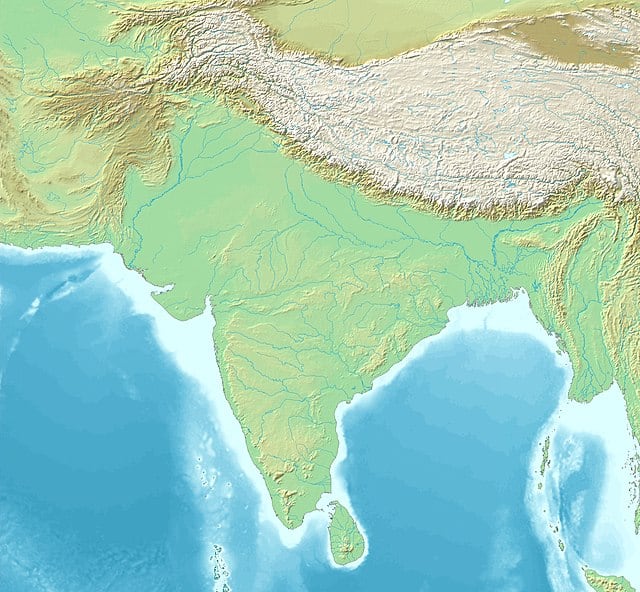
Gandhāra was an ancient region in the Peshawar basin in the far north-west of the ancient Indian subcontinent, corresponding to present-day north-west Pakistan and north-east Afghanistan. The centre of the region was at the confluence of the Kabul and Swat rivers, bounded by the Sulaiman Mountains on the west and the Indus River on the east. The Safed Koh mountains separated it from the Kohat region to the south. This being the core area of Gandhara, the cultural influence of “Greater Gandhara” extended across the Indus river to the Taxila region and westwards into the Kabul and Bamiyan valleys in Afghanistan, and northwards up to the Karakoram range. During the Achaemenid period and Hellenistic period, its capital city was Pushkalavati (Greek: Πευκελαώτις), modern Charsadda. Later the capital city was moved to Peshawar by the Kushan emperor Kanishka the Great in about 127 AD.
Gandhara’s existence is attested since the time of the Rigveda (c. 1500 – c. 1200 BC), as well as the Zoroastrian Avesta, which mentions it as Vaēkərəta, the sixth most beautiful place on earth created by Ahura Mazda. Gandhara was one of sixteen mahajanapadas (large conglomerations of urban and rural areas) of ancient India mentioned in Buddhist sources such as Anguttara Nikaya. Gandhara was conquered by the Achaemenid Empire in the 6th century BC.
Read More About Gandhara Civilization / Source
Gerzeh culture
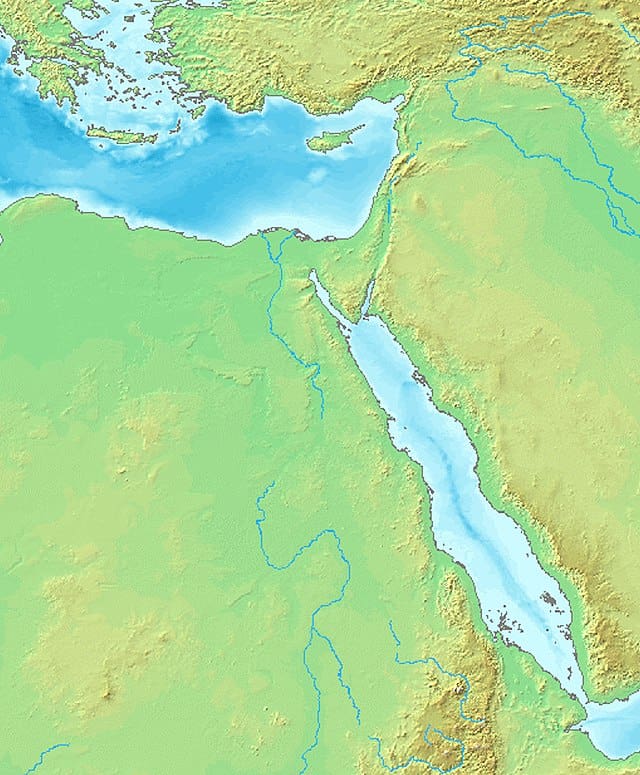
The Gerzeh culture, also called Naqada II, refers to the archaeological stage at Gerzeh (also Girza or Jirzah), a prehistoric Egyptian cemetery located along the west bank of the Nile. The necropolis is named after el-Girzeh, the nearby contemporary town in Egypt. Gerzeh is situated only several miles due east of the oasis of Faiyum.The Gerzeh culture is a material culture identified by archaeologists. It is the second of three phases of the prehistoric Nagada cultures and so is also known as Naqada II. The Gerzeh culture was preceded by the Amratian culture (“Naqada I”) and followed by the Naqada III (“protodynastic” or “Semainian culture”).
Read More About Gerzeh culture / Source
Ghassulian
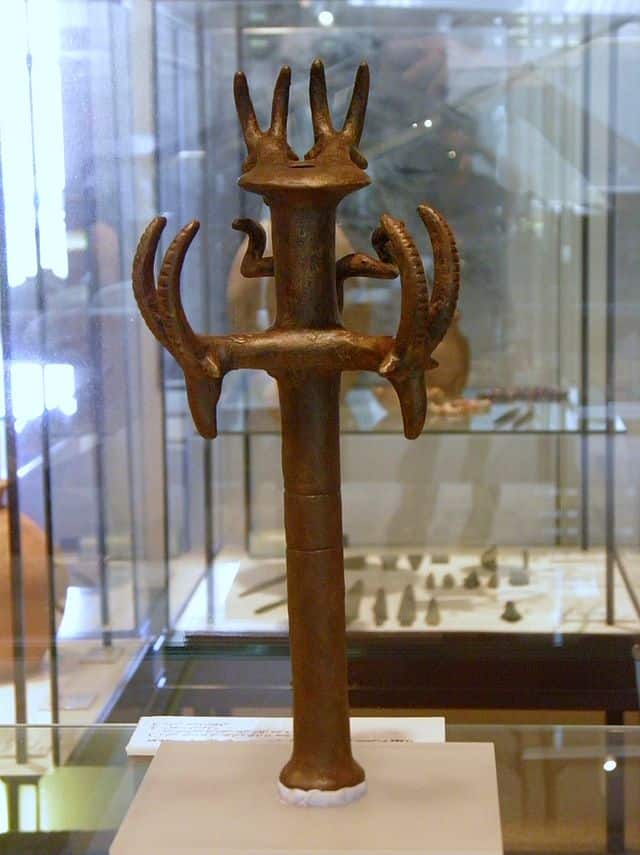
Ghassulian refers to a culture and an archaeological stage dating to the Middle and Late Chalcolithic Period in the Southern Levant (c. 4400 – c. 3500 BC). Its type-site, Teleilat Ghassul (Teleilat el-Ghassul, Tulaylat al-Ghassul), is located in the eastern Jordan Valley near the northern edge of the Dead Sea, in modern Jordan. It was excavated in 1929-1938 and in 1959–1960, by the Jesuits. Basil Hennessy dug at the site in 1967 and in 1975–1977, and Stephen Bourke in 1994–1999.The Ghassulian stage was characterized by small hamlet settlements of mixed farming peoples, who had immigrated from the north and settled in the southern Levant – today’s Jordan, Israel and Palestine. People of the Beersheba Culture (a Ghassulian subculture) lived in underground dwellings – a unique phenomenon in the archaeological history of the region – or in houses that were trapezoid-shaped and built of mud-brick. Those were often built partially underground (on top of collapsed underground dwellings) and were covered with remarkable polychrome wall paintings. Their pottery was highly elaborate, including footed bowls and horn-shaped drinking goblets, indicating the cultivation of wine. Several samples display the use of sculptural decoration or of a reserved slip (a clay and water coating partially wiped away while still wet).
Read More About Ghassulian / Source
Hatti Civilization
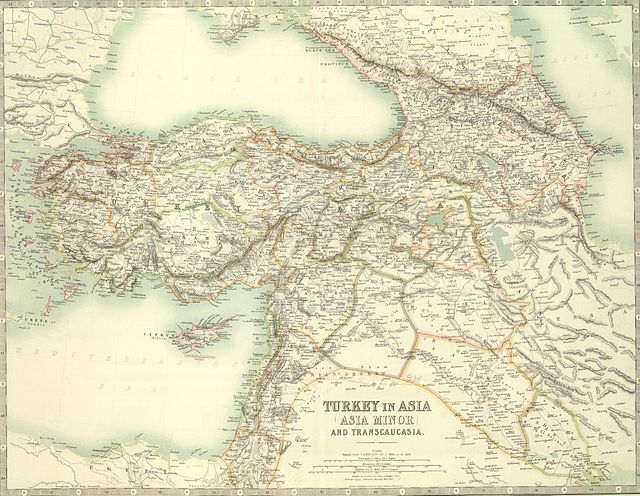
The Hattians were an ancient Bronze Age people, that inhabited the land of Hatti, in central Anatolia (modern Turkey). They spoke a distinctive Hattian language, that was neither Semitic nor Indo-European. Hattians are attested by archeological records from the Early Bronze Age, and also by historical references in later Hittite and other sources. Their main center was the city of Hattush. Faced with Hittite expansion (since c. 2000 BCE), Hattians were gradually absorbed (by c. 1700 BCE) into the new political and social order, imposed by Hittites, who kept the country name (“land of Hatti”), that also became the main designation for the Hittite state.
Read More About Hatti Civilization / Source
Hohokam culture
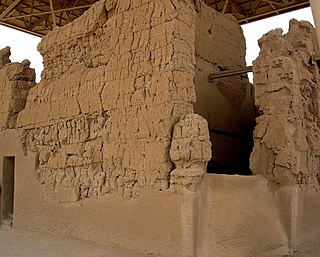
Hohokam was a society in the North American Southwest in what is now part of Arizona, United States, and Mexico. Hohokam practiced a specific culture, sometimes referred to as Hohokam culture, which has been distinguished by archeologists. People who practiced the culture can be called Hohokam as well, but more often, they are distinguished as Hohokam people to avoid confusion.
Most archaeologists agree that the Hohokam culture existed between 300 and 1500 AD, but cultural precursors may have been in the area as early as 300 BC. Whether Hohokam culture was unified politically remains under controversy. Hohokam culture may have just given unrelated neighboring communities common ground to help them to work together to survive their harsh desert environment. According to the National Park Service website, the word Hohokam is borrowed from the O’odham language and is used by archaeologists to identify a group of people who lived in the Sonoran Desert. Other archaeologists prefer to identify ancient Arizona as part of the Oasisamerica tradition and instead call Hohokam the Oasisamericans. Nevertheless, the Hohokam are one of the four major cultures of the American Southwest and northern Mexico, according to Southwestern archaeology.
Read More About Hohokam culture / Source
Hongshan culture
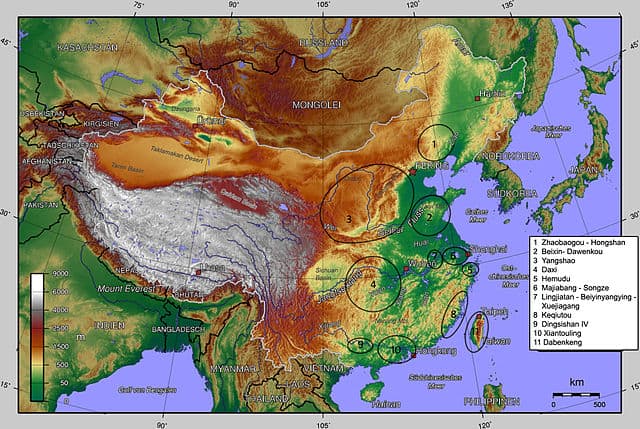
The Hongshan culture was a Neolithic culture in the Liao river basin in northeast China. Hongshan sites have been found in an area stretching from Inner Mongolia to Liaoning, and dated from about 4700 to 2900 BC.The culture is named after Hongshanhou, a site in Hongshan District, Chifeng. The Hongshanhou site was discovered by the Japanese archaeologist Torii Ryūzō in 1908 and extensively excavated in 1935 by Kōsaku Hamada and Mizuno Seiichi.
Read More About Hongshan culture / Source
Iberomaurusian
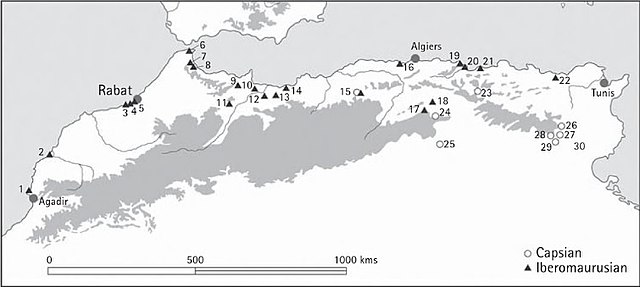
The Iberomaurusian is a backed bladelet lithic industry found near the coasts of Morocco, Algeria, and Tunisia. It is also known from a single major site in Libya, the Haua Fteah, where the industry is locally known as the Eastern Oranian. The Iberomaurusian seems to have appeared around the time of the Last Glacial Maximum (LGM), somewhere between c. 25,000 and 23,000 cal BP. It would have lasted until the early Holocene c. 11,000 cal BP.The name of the Iberomaurusian means “of Iberia and Mauretania”, the latter being a Latin name for Northwest Africa. Pallary (1909) coined this term to describe assemblages from the site of La Mouillah in the belief that the industry extended over the strait of Gibraltar into the Iberian peninsula. This theory is now generally discounted (Garrod 1938), but the name has stuck.
In Algeria, Tunisia, and Libya, but not in Morocco, the industry is succeeded by the Capsian industry, whose origins are unclear. The Capsian is believed either to have spread into North Africa from the Near East, or to have evolved from the Iberomaurusian. In Morocco and Western Algeria, the Iberomaurusian is succeeded by the Cardial culture after a long hiatus.
Read More About Iberomaurusian / Source
Ipiutak culture
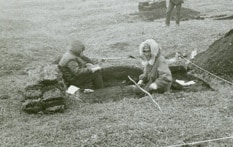
The Ipiutak Site is a large archaeological site at Point Hope in northwest Alaska, United States. It is one of the most important discoveries in this area, competing only with Ekven, Russia. It is the type site for the Ipiutak culture, which arose possibly as early as 100–200 BCE and collapsed around 800 CE. The Ipiutak culture occurred from south of the Bering Strait, across the Brooks Range and possibly as far north as Point Barrow.
The Ipiutak site was discovered in 1939 by archaeologists Helge Larsen and Froelich Rainey, who completed a monograph on the site in 1948. The site consists of nearly 600 abandoned house depressions along four beach ridges that impart a linearity that was originally interpreted as purposeful design as roads or “avenues.” Many of the houses are too close to be contemporaneous and the range of several radiocarbon ages suggests a duration of 300–400 years to build all of the houses. Archaeologists have modeled the population history of the site to infer that only about 125–200 people lived at the site during any one generation and occupied 20 to 30 houses. The original population estimates of over 4000 are in error. Excavations in 1940 and 1941 produced sizable collections from 74 square driftwood constructed houses and over 120 burials, now archived within three museums: the National Museum of Denmark, the American Museum of Natural History and the University of Alaska Fairbanks.
Read More About Ipiutak culture / Source
Jiroft culture
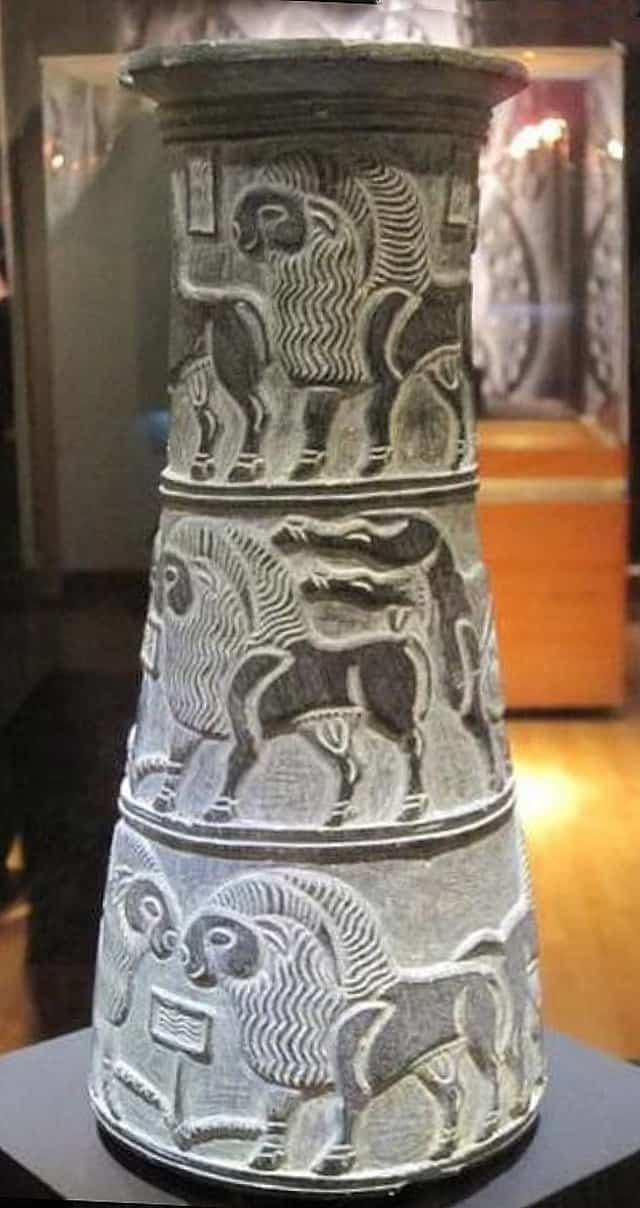
The Jiroft culture also known as the Intercultural style or the Halilrud style, is a postulated early Bronze Age (late 3rd millennium BC) archaeological culture, located in the territory of present-day Balochistan and Kermān Provinces of Iran. The hypothesis is based on a collection of artifacts that have been formally excavated and recovered from looters by Iranian authorities; accepted by many to have derived from the Jiroft area in south central Iran, as reported by online Iranian news services, beginning in 2001.The proposed type site is Konar Sandal, near Jiroft in the Halil River area. Other significant sites associated with the culture include; Shahr-e Sukhteh (Burnt City), Tepe Bampur, Espiedej, Shahdad, Tal-i-Iblis and Tepe Yahya.
The grouping of these sites as an “independent Bronze Age civilization with its own architecture and language”, intermediate between Elam to the west and the Indus Valley Civilization to the east, was first proposed by Yusef Majidzadeh, head of the archaeological excavation team in Jiroft. He speculates that the uncovered remains across these sites constitute the lost Aratta Kingdom, but his conclusions have been met with skepticism from a number of scholars. Other conjectures (e.g. Daniel T. Potts, Piotr Steinkeller) have connected Konar Sandal with the obscure city-state of Marhashi, that apparently lay to the east of Elam proper.
Read More About Jiroft culture / Source
Kachemak Culture
Kachemak culture, a culture found around the Kachemak Bay of the southern Kenai Peninsula in central southern Alaska.
Read More About Kachemak Culture / Source
Keezhadi

Keezhadi is a village near the village of Silaiman, on the border between Madurai and Sivagangai districts, in Tamil Nadu, India. The Keezhadi excavation site is located in this area: excavations carried out by the Archaeological Survey of India (ASI) and the Tamil Nadu Archaeology Department (TNAD) have revealed a Sangam era settlement dated to the 6th century BCE by radiocarbon dating. Claims that the results show that there was writing at that time have been challenged. It is not clear whether the potsherds containing inscriptions were found in the same archaeological layer as the 6th century samples, and University of Calcutta archaeologist Bishnupriya Basak said that This unfortunately is not clear from the report and is very crucial,” adding that the issues of “layer, period and absolute dates” needed clarity. Dravidian University archaeologist E. Harsha Vardhan said that a single report was not enough to “state scientifically that the Tamil-Brahmi script belongs to the sixth century BC”.
Read More About Keezhadi / Source
Khoisan
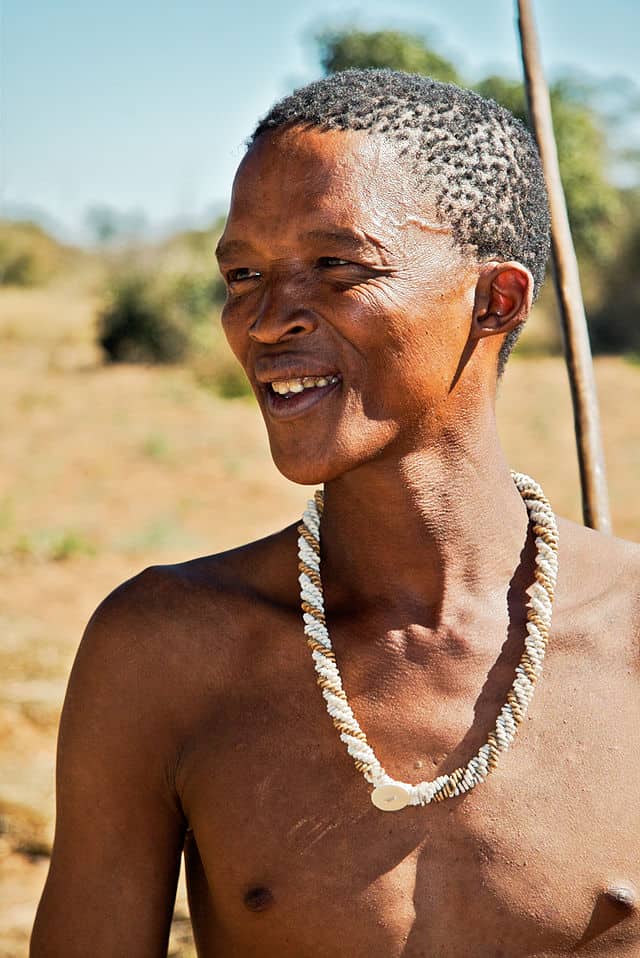
Khoisan, or according to the contemporary Khoekhoegowab orthography Khoe-Sān, is a catch-all term for the “non-Bantu” indigenous peoples of Southern Africa, combining the Khoekhoen (formerly “Khoikhoi”) and the Sān or Sākhoen (also, in Afrikaans: Boesmans, or in English: Bushmen, after Dutch: Boschjesmens; and Saake in the Nǁng language). Khoekhoen, specifically, were formerly known as “Hottentots”, which was an onomatopoeic term (from Dutch hot-en-tot) referring to the click consonants prevalent in the Khoekhoe languages, as they are in all the languages grouped under Khoesān. Dutchmen in the early Cape settlement would ply Khoekhoen with liquor as an inducement for them to perform a ritual dance. The lyric accompanying the dance sounded, in Dutch ears, like hot-en-tot.
Sān are popularly thought of as foragers in the Kalahari Desert and regions of Botswana, Namibia, Angola, Zambia, Zimbabwe, Lesotho and South Africa. The word sān is from the Khoekhoe language and simply refers to foragers (“those who pick things up from the ground”) who do not own livestock. As such it was used in reference to all hunter-gatherer populations of the Southern African region who Khoekhoe-speaking communities came into contact with, and was largely a term referring to a lifestyle, distinct from a pastoralist or agriculturalist one, not any particular ethnicity.
Read More About Khoisan / Source
Kumari Kandam
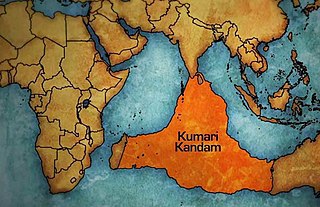
Kumari Kandam refers to a mythical continent, believed to be lost with an ancient Tamil civilization, supposedly located south of present-day India in the Indian Ocean. Alternative name and spellings include Kumarikkandam and Kumari Nadu.
In the 19th century, a section of the European and American scholars speculated the existence of a submerged continent called Lemuria, to explain geological and other similarities between Africa, Australia, India and Madagascar. A section of Tamil revivalists adapted this theory, connecting it to the Pandyan legends of lands lost to the ocean, as described in ancient Tamil and Sanskrit literature. According to these writers, an ancient Tamil civilization existed on Lemuria, before it was lost to the sea in a catastrophe. In the 20th century, the Tamil writers started using the name “Kumari Kandam” to describe this submerged continent. Although the Lemuria theory was later rendered obsolete by the continental drift (plate tectonics) theory, the concept remained popular among the Tamil revivalists of the 20th century. According to them, Kumari Kandam was the place where the first two Tamil literary academies (sangams) were organized during the Pandyan reign. They claimed Kumari Kandam as the cradle of civilization to prove the antiquity of Tamil language and culture.
Read More About Kumari Kandam / Source
kurgan Culture
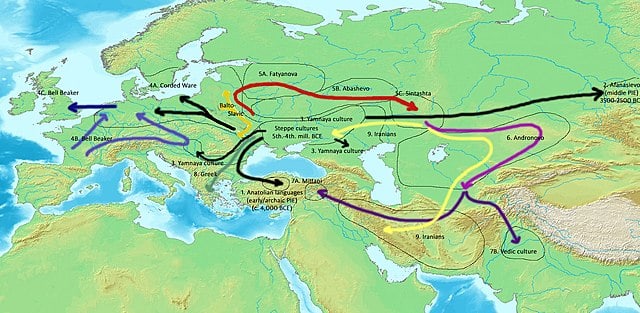
The Kurgan hypothesis (also known as the Kurgan theory or Kurgan model) or Steppe theory is the most widely accepted proposal to identify the Proto-Indo-European homeland from which the Indo-European languages spread out throughout Europe and parts of Asia. It postulates that the people of a Kurgan culture in the Pontic steppe north of the Black Sea were the most likely speakers of the Proto-Indo-European language (PIE). The term is derived from the Russian kurgan (курга́н), meaning tumulus or burial mound. The Steppe theory was first formulated by Otto Schrader (1883) and V. Gordon Childe (1926), then systematized in the 1950s by Marija Gimbutas, who used the term to group various cultures, including the Yamnaya (or Pit Grave), culture and its predecessors. David Anthony instead uses the core Yamnaya culture and its relationship with other cultures as a point of reference.
Gimbutas defined the Kurgan culture as composed of four successive periods, with the earliest (Kurgan I) including the Samara and Seroglazovo cultures of the Dnieper–Volga region in the Copper Age (early 4th millennium BC). The people of these cultures were nomadic pastoralists, who, according to the model, by the early 3rd millennium BC had expanded throughout the Pontic–Caspian steppe and into Eastern Europe.
Read More About kurgan Culture / Source
Lapita culture
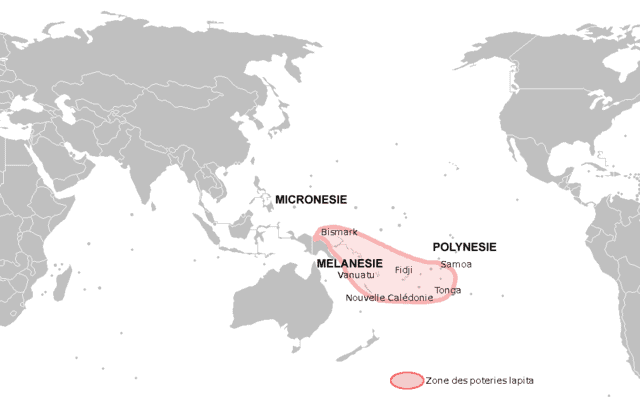
The Lapita culture is the name given to a prehistoric Pacific Ocean people who left evidence of their livelihood on several Pacific Islands, in the form of ceramic objects that range in date from about 1600 BCE to about 500 BCE. Some archaeologists believe that the Lapita are the ancestors of historic cultures in Polynesia, Micronesia, and some coastal areas of Melanesia. Others believe that these are two distinct cultures that evolved separately within shared areas. The historically recognized characteristic of the Lapita culture is a distinctive geometric design on dentate-stamped pottery.
Read More About Lapita culture / Source
LBK Culture
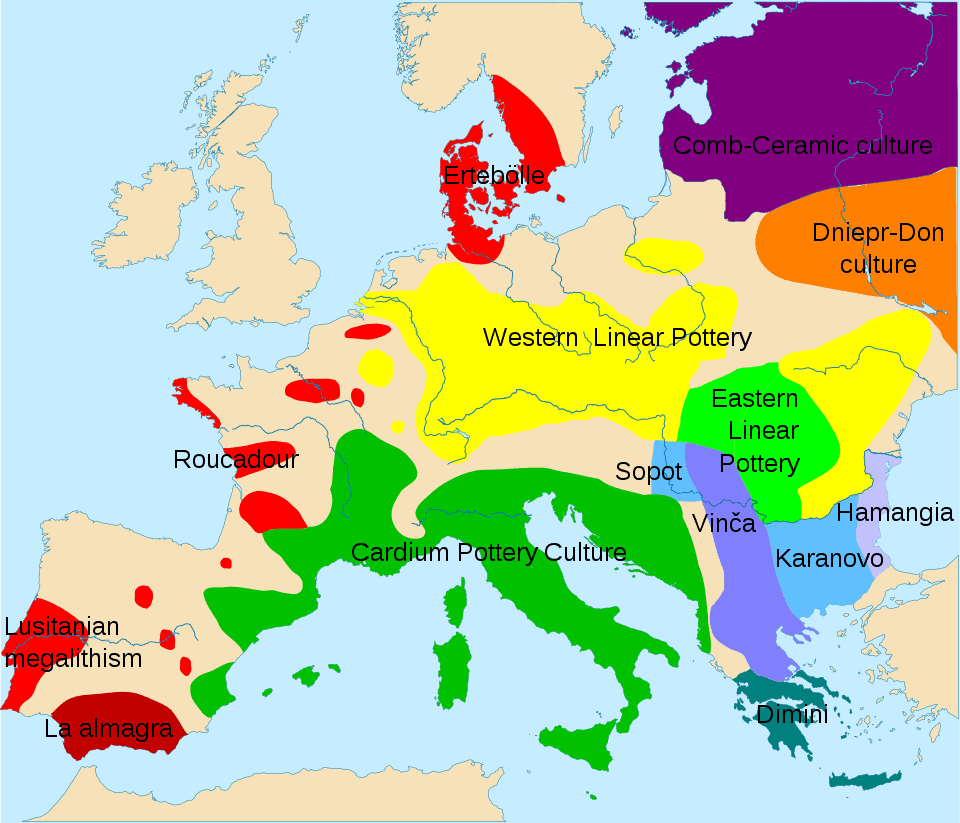
The Linear Pottery culture is a major archaeological horizon of the European Neolithic, flourishing c. 5500–4500 BC. It is abbreviated as LBK (from German: Linearbandkeramik), and is also known as the Linear Band Ware, Linear Ware, Linear Ceramics or Incised Ware culture, and falls within the Danubian I culture of V. Gordon Childe.
The densest evidence for the culture is on the middle Danube, the upper and middle Elbe, and the upper and middle Rhine. It represents a major event in the initial spread of agriculture in Europe. The pottery after which it was named consists of simple cups, bowls, vases, and jugs, without handles, but in a later phase with lugs or pierced lugs, bases, and necks.Important sites include Nitra in Slovakia; Bylany in the Czech Republic; Langweiler and Zwenkau in Germany; Brunn am Gebirge in Austria; Elsloo, Sittard, Köln-Lindenthal, Aldenhoven, Flomborn, and Rixheim on the Rhine; Lautereck and Hienheim on the upper Danube; and Rössen and Sonderhausen on the middle Elbe.
Read More About LBK Culture / Source
Lepenski Vir
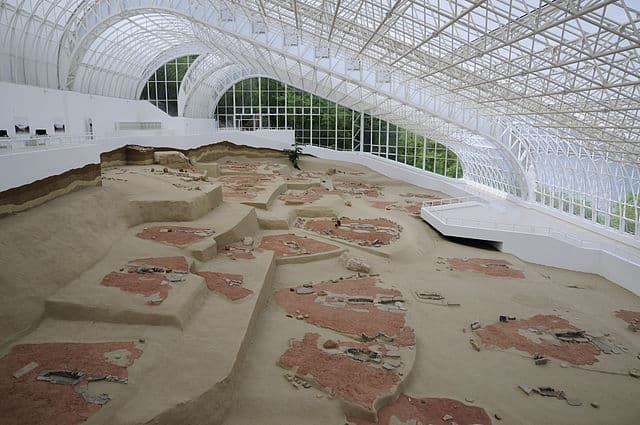
Lepenski Vir, located in Serbia, is an important archaeological site of the Mesolithic Iron Gates culture of the Balkans. The latest radiocarbon and AMS data suggests that the chronology of Lepenski Vir spans between 9500/7200–6000 BC. There is some disagreement about when the settlement and culture of Lepenski Vir began, but the latest data indicates that it was between 9500–7200 BC. The late Lepenski Vir (6300–6000 BC) architectural phase saw the development of unique trapezoidal buildings and monumental sculpture. The Lepenski Vir site consists of one large settlement with around ten satellite villages. Numerous piscine sculptures and peculiar architectural remains have been found at the site.
Archaeologist Dragoslav Srejović, who first explored the site, said that such large sculptures so early in human history, and the original architectural solutions, define Lepenski Vir as a specific and very early phase in the development of European prehistoric culture. The site was notable for its outstanding level of preservation and the overall exceptional quality of its artifacts. Because the settlement was permanent and planned, with an organized societal life, architect Hristivoje Pavlović labeled Lepenski Vir as “the first city in Europe”.
Read More About Lepenski Vir / Source
Liangzhu culture
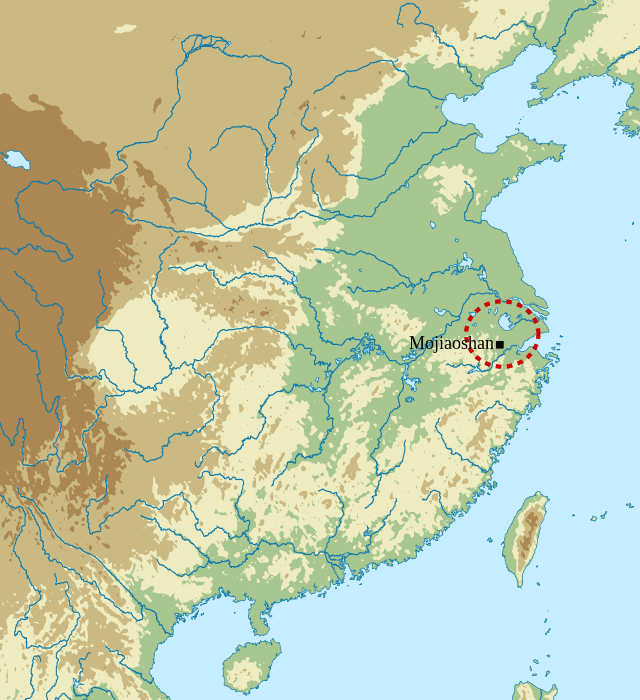
The Liangzhu culture ( 3400–2250 BC) was the last Neolithic jade culture in the Yangtze River Delta of China. The culture was highly stratified, as jade, silk, ivory and lacquer artifacts were found exclusively in elite burials, while pottery was more commonly found in the burial plots of poorer individuals. This division of class indicates that the Liangzhu period was an early state, symbolized by the clear distinction drawn between social classes in funeral structures. A pan-regional urban center had emerged at the Liangzhu city-site and elite groups from this site presided over the local centers. The Liangzhu culture was extremely influential and its sphere of influence reached as far north as Shanxi and as far south as Guangdong. The primary Liangzhu site was perhaps among the oldest Neolithic sites in East Asia that would be considered a state society. The type site at Liangzhu was discovered in Yuhang County, Zhejiang and initially excavated by Shi Xingeng in 1936. A 2007 analysis of the DNA recovered from human remains shows high frequencies of Haplogroup O1 in Liangzhu culture linking this culture to modern Austronesian and Tai-Kadai populations. It is believed that the Liangzhu culture or other associated subtraditions are the ancestral homeland of Austronesian speakers.On 6 July 2019, Liangzhu was inscribed as a UNESCO World Heritage Site.
Read More About Liangzhu culture / Source
Longshan culture
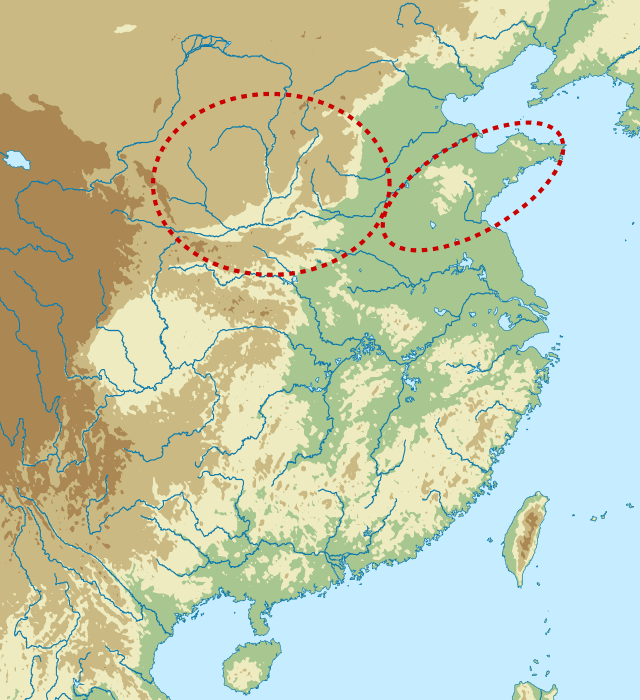
The Longshan (or Lung-shan) culture, also sometimes referred to as the Black Pottery Culture, was a late Neolithic culture in the middle and lower Yellow River valley areas of northern China from about 3000 to 1900 BC. The first archaeological find of this culture took place at the Chengziya Archaeological Site in 1928, with the first excavations in 1930 and 1931. The culture is named after the nearby modern town of Longshan (lit. “Dragon Mountain”) in Zhangqiu, Shandong. The culture was noted for its highly polished black pottery (or egg-shell pottery). The population expanded dramatically during the 3rd millennium BC, with many settlements having rammed earth walls. It decreased in most areas around 2000 BC until the central area evolved into the Bronze Age Erlitou culture.
Read More About Longshan culture / Source
Lupemban culture
The Lupemban is the name given by archaeologists to a central African culture which, though once thought to date between c. 30,000 and 12,000 BC, is now generally recognised to be far older (dates of c. 300,000 have been obtained from Twin Rivers, Zambia and Muguruk, Kenya, respectively). The industry is characterised by the occurrence of bi-facially flaked lanceolate points. It has been postulated that Lupemban tools, being generally distributed within the modern day Congo forest belt, may have been adapted to woodworking. The lanceolate points are commonly interpreted as being the surviving elements of composite spears.Activity sites include: Kalambo Falls and Dundo.
Read More About Lupemban culture / Source
Maglemosian culture
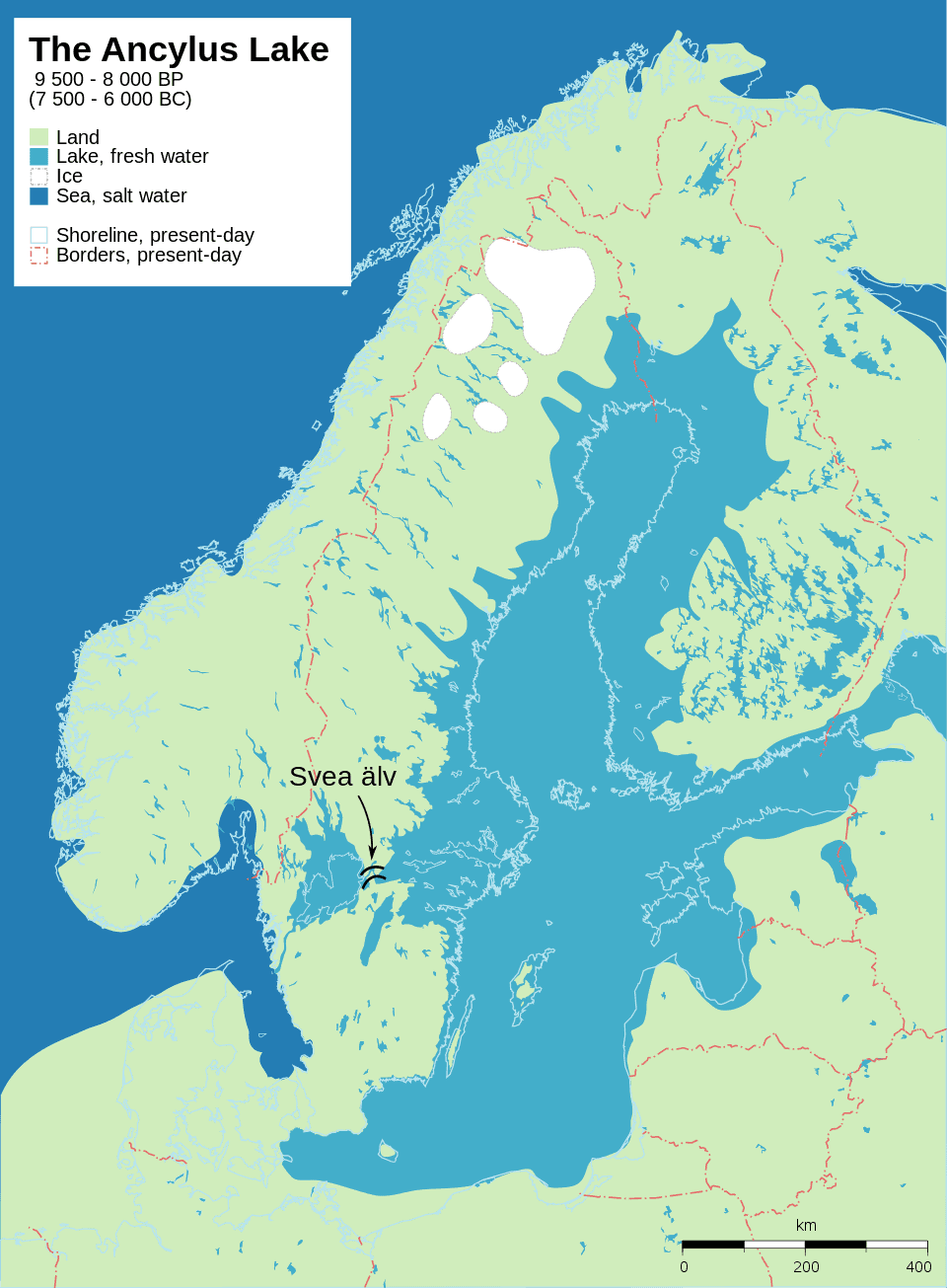
Maglemosian (c. 9000 – c. 6000 BC) is the name given to a culture of the early Mesolithic period in Northern Europe. In Scandinavia, the culture was succeeded by the Kongemose and Tardenoisian culture. The name originates from the Danish archeological site Maglemose, situated near Gørlev and Høng on western Zealand, southwest of lake Tissø. Here the first settlement of the culture was excavated in 1900, by George Sarauw. During the following century a long series of similar settlements were excavated from England to Poland and from Skåne in Sweden to northern France.
Read More About Maglemosian culture / Source
Magosian
The Magosian is the name given by archaeologists to an industry found in southern and eastern Africa. It dates to between 10,000 and 6,000 years BC and is distinguished from its predecessors by the use of microliths and small blades. In 1953, J. Desmond Clark found a notable site of Magosian artifacts at Kalambo Falls, on what is now the border between Zambia and Tanzania.
Read More About Magosian / Source
Maya civilization
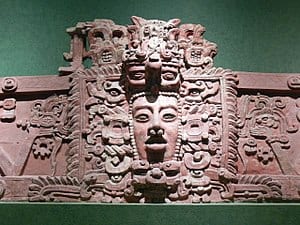
The Maya civilization was a Mesoamerican civilization developed by the Maya peoples, and noted for its logosyllabic script—the most sophisticated and highly developed writing system in pre-Columbian Americas—as well as for its art, architecture, mathematics, calendar, and astronomical system. The Maya civilization developed in the area that today comprises southeastern Mexico, all of Guatemala and Belize, and the western portions of Honduras and El Salvador. It includes the northern lowlands of the Yucatán Peninsula and the highlands of the Sierra Madre, the Mexican state of Chiapas, southern Guatemala, El Salvador, and the southern lowlands of the Pacific littoral plain. “Maya” is a modern term used to refer collectively to the various peoples that inhabited this area. They did not call themselves “Maya,” and did not have a sense of common identity or political unity. Today, their descendants, known collectively as the Maya, number well over 6 million individuals, speak more than twenty-eight surviving Mayan languages, and reside in nearly the same area as their ancestors.
Read More About Maya civilization / Source
Mesopotamia
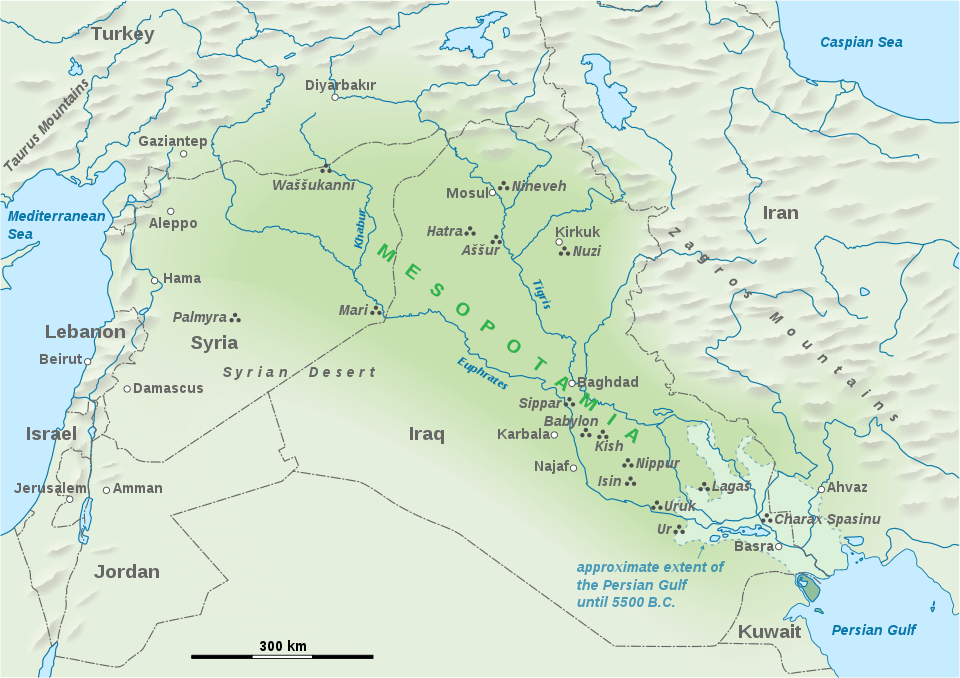
Mesopotamia is a historical region of Western Asia situated within the Tigris–Euphrates river system, in the northern part of the Fertile Crescent. It occupies the area of present-day Iraq, Kuwait, and parts of Iran, Syria, and Turkey. The Sumerians and Akkadians (including Assyrians and Babylonians) dominated Mesopotamia from the beginning of written history (c. 3100 BC) to the fall of Babylon in 539 BC, when it was conquered by the Achaemenid Empire. It fell to Alexander the Great in 332 BC, and after his death, it became part of the Greek Seleucid Empire. Later the Arameans dominated major parts of Mesopotamia (c. 900 BC – 270 AD).
Read More About Mesopotamia / Source
Minoan civilization

The Minoan civilization was a Bronze Age Aegean civilization on the island of Crete and other Aegean Islands, flourishing from c. 3000 BC to c. 1450 BC and, after a late period of decline, finally ending around 1100 BC, during the early Greek Dark Ages. It represents the first advanced civilization in Europe, leaving behind massive building complexes, tools, artwork, writing systems, and a massive network of trade. The civilization was rediscovered at the beginning of the 20th century through the work of British archaeologist Sir Arthur Evans. The name “Minoan” derives from the mythical King Minos and was coined by Evans, who identified the site at Knossos with the labyrinth and the Minotaur. The Minoan civilization has been described as the earliest of its kind in Europe, and historian Will Durant called the Minoans “the first link in the European chain”.
Read More About Minoan civilization / Source
Moche culture
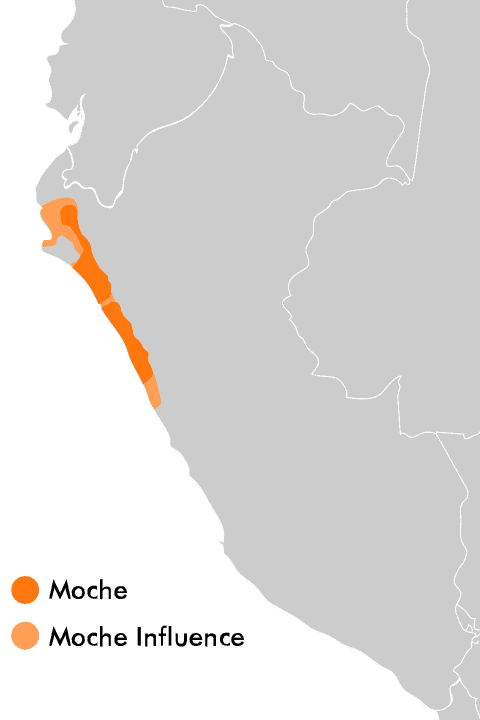
The Moche civilization flourished in northern Peru with its capital near present-day Moche, Trujillo, Peru from about 100 to 700 AD during the Regional Development Epoch. While this issue is the subject of some debate, many scholars contend that the Moche were not politically organized as a monolithic empire or state. Rather, they were likely a group of autonomous polities that shared a common culture, as seen in the rich iconography and monumental architecture that survives today.
Read More About Moche culture / Source
Mousterian
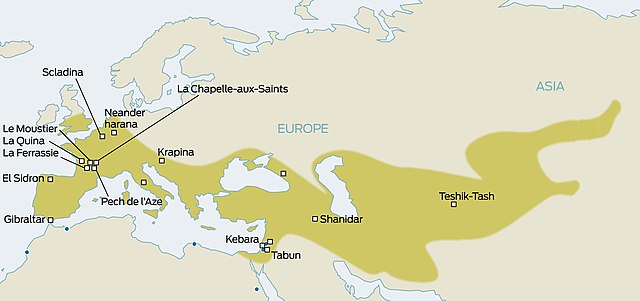
The Mousterian (or Mode III) is a techno-complex (archaeological industry) of stone tools, associated primarily with the Neanderthals in Europe, and to a lesser extent the earliest anatomically modern humans in North Africa and West Asia. The Mousterian largely defines the latter part of the Middle Paleolithic, the middle of the West Eurasian Old Stone Age. It lasted roughly from 160,000 to 40,000 BP. If its predecessor, known as Levallois or Levallois-Mousterian, is included, the range is extended to as early as c. 300,000–200,000 BP. The main following period is the Aurignacian (c. 43,000–28,000 BP) of Homo sapiens.
Read More About Mousterian / Source
Mycenaean civilization
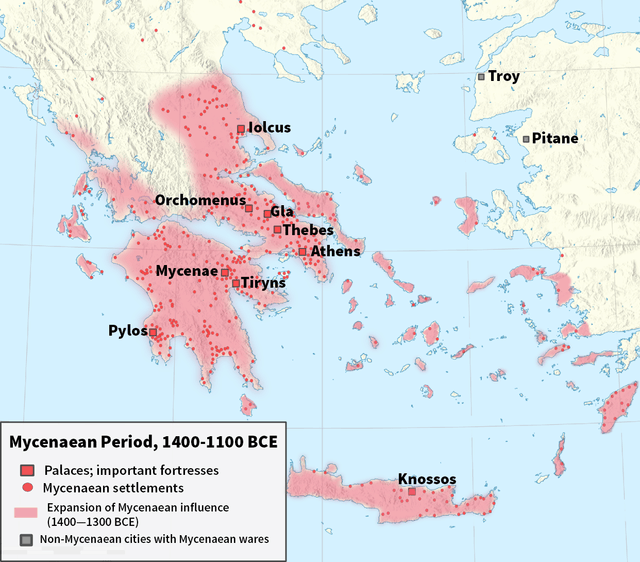
Mycenaean Greece (or the Mycenaean civilization) was the last phase of the Bronze Age in Ancient Greece, spanning the period from approximately 1600–1100 BC. It represents the first advanced and distinctively Greek civilization in mainland Greece with its palatial states, urban organization, works of art, and writing system. The most prominent site was Mycenae, in the Argolid, after which the culture of this era is named. Other centers of power that emerged included Pylos, Tiryns, Midea in the Peloponnese, Orchomenos, Thebes, Athens in Central Greece and Iolcos in Thessaly. Mycenaean and Mycenaean-influenced settlements also appeared in Epirus, Macedonia, on islands in the Aegean Sea, on the coast of Asia Minor, the Levant, Cyprus, and Italy.The Mycenaean Greeks introduced several innovations in the fields of engineering, architecture and military infrastructure, while trade over vast areas of the Mediterranean was essential for the Mycenaean economy. Their syllabic script, the Linear B, offers the first written records of the Indo-European Greek language, and their religion already included several deities that can also be found in the Olympic Pantheon. Mycenaean Greece was dominated by a warrior elite society and consisted of a network of palace-centered states that developed rigid hierarchical, political, social and economic systems. At the head of this society was the king, known as a wanax.
Read More About Mycenaean civilization / Source
Nachikufan industry
Nachikufan industry, industry of the African Late Stone Age practiced by hunting-gathering peoples who occupied the wooded plateaus of south-central Africa some 10,000–11,000 years ago.
Read More About Nachikufan industry / Source
Nazca Culture
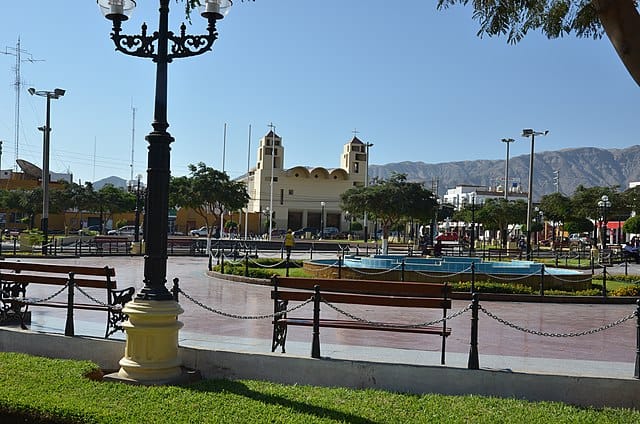
Nazca (sometimes spelled Nasca; Quechua: Naska) is a city and system of valleys on the southern coast of Peru. It is also the name of the largest existing town in the Nazca Province. The name is derived from the Nazca culture, which flourished in the area between 100 BC and AD 800. This culture was responsible for the Nazca Lines and the ceremonial city of Cahuachi. They also constructed additional underground aqueducts, named puquios, in a regional system that still functions today. The first puquios are believed to have been built by the preceding Paracas culture. Nazca is the capital of the Nazca Province located in the Ica District of the Ica region of Peru.
Read More About Nazca Culture / Source
Nok culture
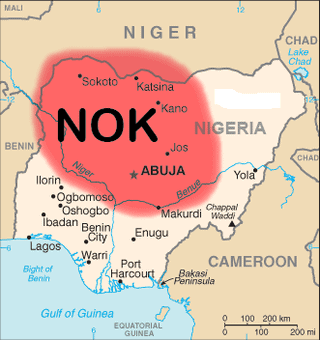
The Nok culture (or Nok civilization) is an early Iron Age population whose material remains are named after the Ham village of Nok in Kaduna State of Nigeria, where their terracotta sculptures were first discovered in 1928. The Nok Culture appeared in Nigeria around 1500 BC and vanished under unknown circumstances around 500 AD, having lasted approximately 2,000 years.Iron use, in smelting and forging tools, appears in Nok culture by at least 550 BC and possibly a few centuries earlier. Data from historical linguistics suggest that iron smelting was independently discovered in the region by 1000 BC. Scientific field work began in 2005 to systematically investigate Nok archaeological sites and to better understand Nok terracotta sculptures within their Iron Age archaeological context.
Read More About Nok culture / Source
Norte Chico civilization
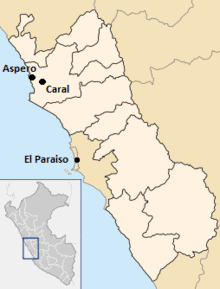
The Caral Civilization (also Norte Chico civilization or Caral-Supe civilization) was a complex pre-Columbian-era society that included as many as thirty major population centers in what is now the Norte Chico region of north-central coastal Peru. The civilization flourished between the fourth and second millennia BC, with the formation of the first city generally dated to around 3500 BC, at Huaricanga, in the Fortaleza area. It is from 3100 BC onward that large-scale human settlement and communal construction become clearly apparent, which lasted until a period of decline around 1800 BC. Since the early 21st century, it has been established as the oldest-known civilization in the Americas.
This civilization flourished along three rivers, the Fortaleza, the Pativilca, and the Supe. These river valleys each have large clusters of sites. Further south, there are several associated sites along the Huaura River. The alternative name, Caral-Supe, is derived from the city of Caral in the Supe Valley, a large and well-studied Norte Chico site. Complex society in Norte Chico arose a millennium after Sumer in Mesopotamia, was contemporaneous with the Egyptian pyramids, and predated the Mesoamerican Olmec by nearly two millennia.
Read More About Norte Chico civilization / Source
Old Cordilleran Culture
The Old Cordilleran Culture, also known as the Cascade phase, is an ancient culture of Native Americans that settled in the Pacific Northwestern region of North America that existed from 9000 or 10000 BC until about 5500 BC.
The Cascade phase may be even older, depending on when human beings first arrived in America. They originated in Alaska, and migrated to occupy a wide area as far as Idaho and the plateaus of California, but they are generally not considered to be a maritime society. However, their spear points, or points resembling theirs, have been found as far south as Mexico and South America. This was the typical artifact of these people — a simple, bi-facial, leaf-shaped projectile point which average about 6 cm (2.4 in) in length. These tools were used as spears or darts, or also knives, indicating the importance of hunting, although they also fished and gathered for subsistence. However, the main dependence was on land hunting, mostly of deer, bison, and other large mammals.The culture possibly spoke a Macro-Penutian language (a hypothetical macrofamily which may include Penutian, Uto-Aztecan, and some other language families). This culture also created the oldest attested examples of art in the Pacific Northwest.
Read More About Old Cordilleran Culture / Source
Olmecs
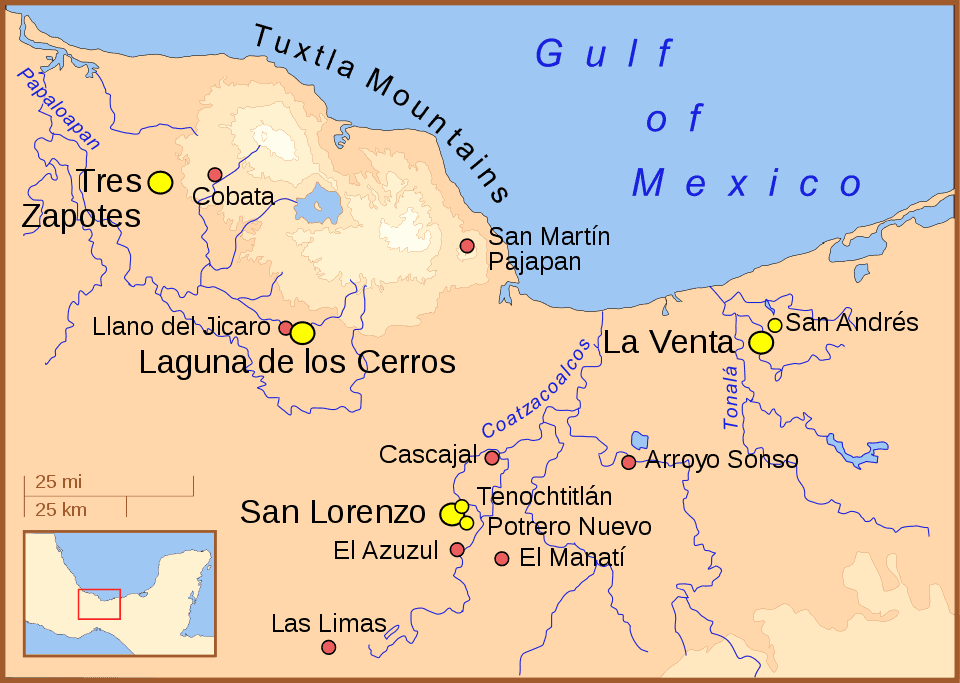
The Olmecs () were the earliest known major Mesoamerican civilization. Following a progressive development in Soconusco, they occupied the tropical lowlands of the modern-day Mexican states of Veracruz and Tabasco. It has been speculated that the Olmecs derived in part from the neighboring Mokaya or Mixe–Zoque cultures.
The Olmecs flourished during Mesoamerica’s formative period, dating roughly from as early as 1500 BCE to about 400 BCE. Pre-Olmec cultures had flourished since about 2500 BCE, but by 1600–1500 BCE, early Olmec culture had emerged, centered on the San Lorenzo Tenochtitlán site near the coast in southeast Veracruz. They were the first Mesoamerican civilization, and laid many of the foundations for the civilizations that followed. Among other “firsts”, the Olmec appeared to practice ritual bloodletting and played the Mesoamerican ballgame, hallmarks of nearly all subsequent Mesoamerican societies. The aspect of the Olmecs most familiar now is their artwork, particularly the aptly named “colossal heads”. The Olmec civilization was first defined through artifacts which collectors purchased on the pre-Columbian art market in the late 19th century and early 20th centuries. Olmec artworks are considered among ancient America’s most striking.
Read More About Olmecs / Source
Osteodontokeratic culture
The Osteodontokeratic (“bone-tooth-horn”, Greek and Latin derivation) culture (ODK) is a hypothesis that was developed by Prof. Raymond Dart (who identified the Taung child fossil in 1924, and published the find in Nature Magazine in 1925), which detailed the predatory habits of Australopith species in South Africa involving the manufacture and use of osseous implements. Dart envisaged Australopithecus africanus, known from Taung and Sterkfontein caves, and Australopithecus prometheus (now classified as Au. africanus) from Makapansgat, as carnivorous, cannibalistic predators who utilized bone and horn implements to hunt various animals, such as antelopes and primates, as well as other Australopiths.
Read More About Osteodontokeratic culture / Source
Paracas culture
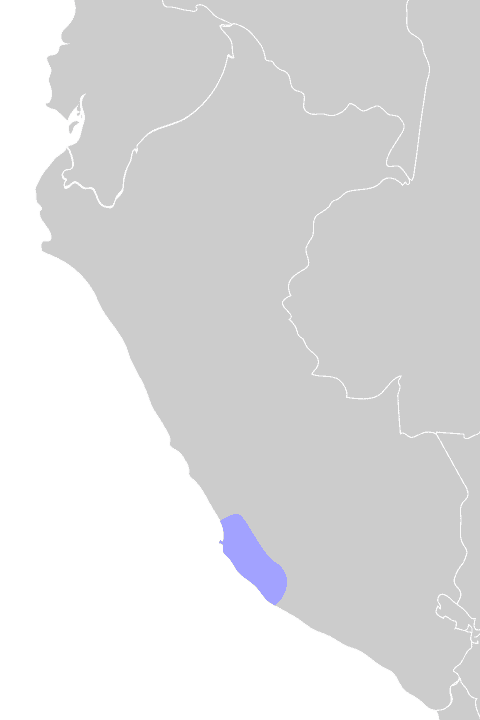
The Paracas culture was an Andean society existing between approximately 800 BCE and 100 BCE, with an extensive knowledge of irrigation and water management and that made significant contributions in the textile arts. It was located in what today is the Ica Region of Peru. Most information about the lives of the Paracas people comes from excavations at the large seaside Paracas site on the Paracas Peninsula, first formally investigated in the 1920s by Peruvian archaeologist Julio Tello.
The Paracas Cavernas are shaft tombs set into the top of Cerro Colorado, each containing multiple burials. There is evidence that over the centuries when the culture thrived, these tombs were reused. In some cases, the heads of the deceased were taken out, apparently for rituals, and later reburied. The associated ceramics include incised polychrome, “negative” resist decoration, and other wares of the Paracas tradition. The associated textiles include many complex weave structures, as well as elaborate plaiting and knotting techniques.
Read More About Paracas culture / Source
Perigordian
Périgordian is a term for several distinct but related Upper Palaeolithic cultures which are thought by some archaeologists to represent a contiguous tradition. Thought to have existed between c.35,000 BP and c.20,000 BP the Perigordian was theorized by prehistorians (namely Denis Peyrony).The earliest culture in the tradition is the Châtelperronian which is thought to have produced denticulate tools and flint knives. It is argued that this was superseded by the Gravettian with its Font Robert points and Noailles burins. The tradition culminated in the proto-Magdalenian.Critics have pointed out that no continuous sequence of Périgordian occupation has yet been found, and that the tradition requires it to have co-existed separately from the Aurignacian industry rather than being differing industries that existed before and afterwards.
Read More About Perigordian / Source
Philistines
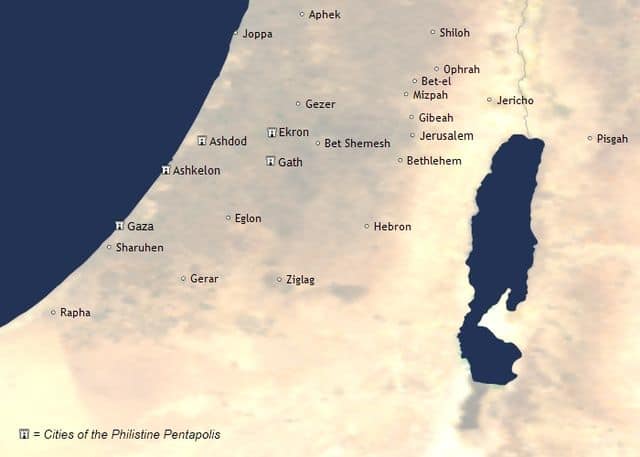
The Philistines were an ancient people who lived on the south coast of Canaan from the 12th century BC until 604 BC, when their polity, after having already been subjugated for centuries by Assyria, was finally destroyed by King Nebuchadnezzar II of Babylonia. After becoming part of his empire and its successor, the Persian Empire, they lost their distinct ethnic identity and disappeared from the historical and archaeological record by the late 5th century BC. The Philistines are known for their biblical conflict with the Israelites. Though the primary source of information about the Philistines is the Hebrew Bible, they are first attested to in reliefs at the Temple of Ramses III at Medinet Habu, in which they are called Peleset (accepted as cognate with Hebrew Peleshet); the parallel Assyrian term is Palastu, Pilišti, or Pilistu.Several theories are given about the origins of the Philistines. The Hebrew Bible mentions in two places that they originate from Caphtor (possibly Crete/Minoa). The Septuagint connects the Philistines to other biblical groups such as Caphtorim and the Cherethites and Pelethites, which have been identified with the island of Crete. This has led to the modern theory of Philistines having an Aegean origin.
Read More About Philistines / Source
Pre-Columbian era
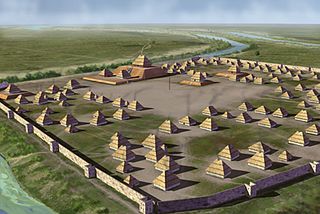
In the history of the Americas, the pre-Columbian era spans from the original settlement of North and South America in the Upper Paleolithic period through European colonization, which began with Christopher Columbus’s voyage of 1492. Usually the era covers the history of indigenous American cultures until significant influence by Europeans. This may have occurred decades or even centuries after Columbus for certain cultures.
Read More About Pre-Columbian era / Source
Qijia culture
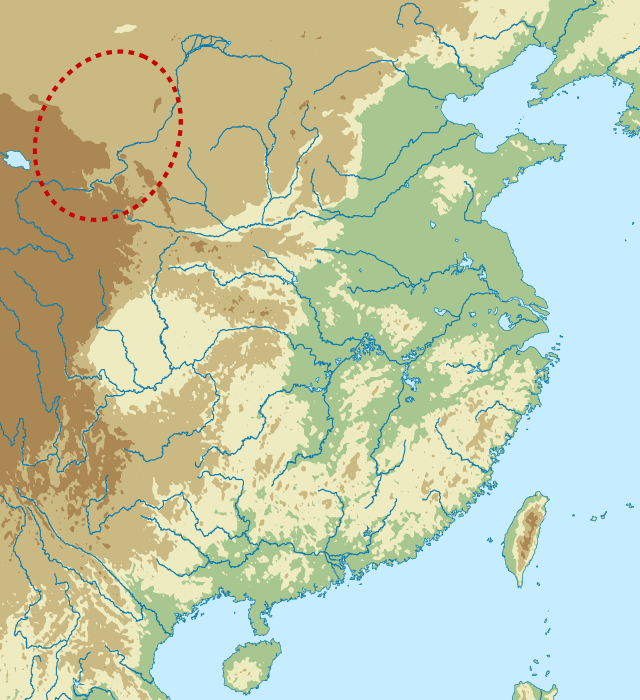
The Qijia culture (2200 BC – 1600 BC) was an early Bronze Age culture distributed around the upper Yellow River region of Gansu (centered in Lanzhou) and eastern Qinghai, China. It is regarded as one of the earliest bronze cultures in China. The Qijia Culture is named after the Qijiaping Site in Gansu Province.
Prior to Qijia culture, in the same area there existed Majiayao culture that was also familiar with metalwork. At the end of the third millennium B.C., Qijia culture succeeded Majiayao culture at sites in three main geographic zones: Eastern Gansu, Middle Gansu, and Western Gansu/Eastern Qinghai.
Read More About Qijia culture / Source
Recuay culture
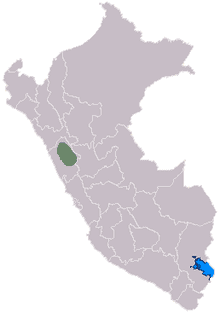
The Recuay culture was a pre-Columbian culture of highland Peru that flourished from 200 BCE to 600 CE and was related to the Moche culture of the north coast. It is named after the Recuay District, in the Recuay Province, in the Ancash Region of Peru. This culture developed in the Callejón de Huaylas valley, and its artistic style is also known as “Huaylas.”
Read More About Recuay culture / Source
Riwat
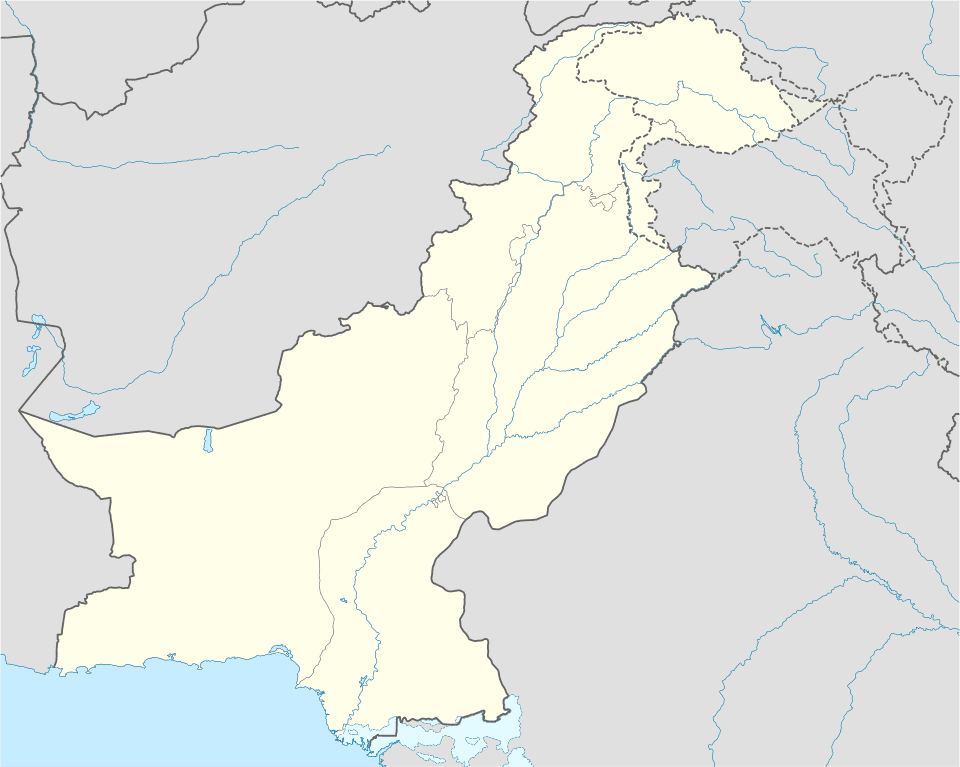
Riwat (Rawat, Murree) is a Paleolithic site in Punjab, northern Pakistan. Another site, called Riwat Site 55, shows a later occupation dated to around 45,000 years ago. The site was discovered in 1983. The artifacts consist of flakes and cores made of quartzite. The collection of pebble tools is claimed to be 1.9 million years old and has been disputed because the artifacts weren’t found in their original context. The claims of the dating of the site are being continuously researched.
Read More About Riwat / Source
San people

The San peoples (also Saan), or Bushmen, are members of various Khoe, Tuu, or Kxʼa-speaking indigenous hunter-gatherer groups that are the first nations of Southern Africa, and whose territories span Botswana, Namibia, Angola, Zambia, Zimbabwe, Lesotho and South Africa. In 2017, Botswana was home to approximately 63,500 San people, which is roughly 2.8% of the country’s population, making it the country with the highest population of San people.
Read More About San people / Source
Sangoan
The Sangoan archaeological industry is the name given by archaeologists to a Palaeolithic tool manufacturing style which may have developed from the earlier Acheulian types. In addition to the Acheulian stone tools, use was also made of bone and antler picks. Sangoan toolkit was used especially for grubbing.
The Sangoan period is broadly analogous to the Mousterian culture in Europe and is dated to about 130,000 to 10,000 years ago.
It is named after the site of Sango Bay in Uganda where it was first discerned in 1920. The peoples who used Sangoan tools were hunting and gathering cultures, also known as the Sangoan, who occupied southern Africa in areas where annual rainfall is less than 40 inches (1016 mm) from the beginning of the Upper Paleolithic period. The Sangoan industry was distributed broadly from present day Botswana to Ethiopia. In the Kalahari Desert, many prehistoric stone tools have been recovered by archaeologists dating at least as early as the period of the Sangoan culture. It also went as far west as the forested regions of the Congo.
Read More About Sangoan / Source
Shahr-e Sukhteh
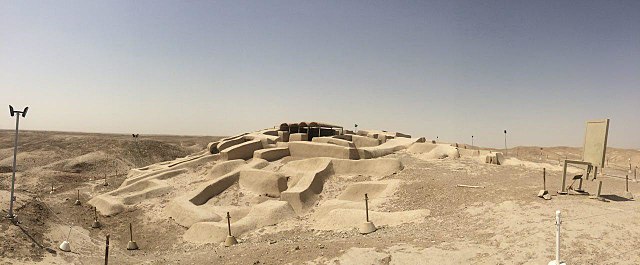
Shahr-e Sukhteh, also spelled as Shahr-e Sūkhté and Shahr-i Sōkhta, is an archaeological site of a sizable Bronze Age urban settlement, associated with the Jiroft culture. It is located in Sistan and Baluchistan Province, the southeastern part of Iran, on the bank of the Helmand River, near the Zahedan-Zabol road. It was placed on the UNESCO World Heritage List in June 2014.
The reasons for the unexpected rise and fall of the city are still wrapped in mystery. Artifacts recovered from the city demonstrate a peculiar incongruity with nearby civilizations of the time and it has been speculated that Shahr-e-Sukhteh might ultimately provide concrete evidence of a civilization east of prehistoric Persia that was independent of ancient Mesopotamia.
Read More About Shahr-e Sukhteh / Source
Solutrean industry
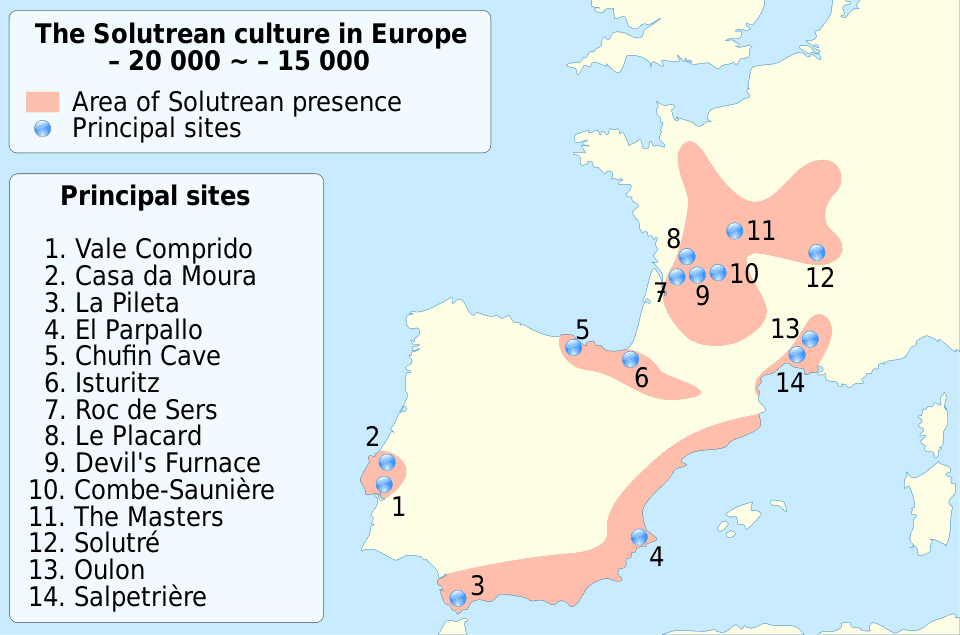
The Solutrean industry is a relatively advanced flint tool-making style of the Upper Paleolithic of the Final Gravettian, from around 22,000 to 17,000 BP. Solutrean sites have been found in modern-day France, Spain and Portugal.
Read More About Solutrean industry / Source
Stillbay
The Stillbay (also Still bay) industry is the name given by archaeologists A. J. H. Goodwin and C. van Riet Lowe in 1929 to a Middle Stone Age stone tool manufacturing style after the site of Stilbaai (also called Still Bay) in South Africa where it was first described. It may have developed from the earlier Acheulian types. In addition to Acheulian stone tools, bone and antler picks were also used. Its start and end are calculated at 71.9 ka and 71.0 ka. At present, too few data exist to limit the 95% confidence intervals of these date to more than 4 to 5 ky. However, available data are consistent with a duration of less than 1 ky.Sampson in 1974 questioned its existence on the grounds that sites were not properly described and they lacked stratigraphic integrity However, more recent work from sites such as Blombos Cave and Sibudu Cave attest to its existence. It is broadly analogous to the Mousterian culture in Europe. Olduvai Gorge has within its many ages of tools, some of the Stillbay variety.
Read More About Stillbay / Source
Tasian culture
The Tasian culture is possibly the oldest-known Predynastic culture in Upper Egypt, which evolved around 4500 BC. It is named for the burials found at Deir Tasa, a site on the east bank of the Nile located between Asyut and Akhmim. The Tasian culture group is notable for producing the earliest blacktop-ware, a type of red and brown pottery, which has been painted black on its top and interior. This pottery is vital to the dating of the various predynastic Egyptian civilizations. Since all dates for the Predynastic period are tenuous at best, Flinders Petrie developed a system called Sequence Dating through which the relative date, if not the absolute date, of any given Predynastic site can be ascertained by examining the handles on pottery.
As the Predynastic period in ancient Egypt progressed, the handles on pottery evolved from functional to ornamental, and the degree to which any given archaeological site has functional or ornamental pottery can be used to determine the relative date of the site. Since there is little difference between Tasian and Badarian pottery, the Tasian Culture overlaps the Badarian place on the scale between Sequence Dating 21 and 29 significantly.Excavations of Tasian burials have yielded a number of skeletons. The fossils are generally taller and more robust than later predynastic Egyptian specimens. In this regard, the Tasian skeletons are most similar to those associated with the Merimde culture.
Read More About Tasian culture / Source
Tayacian industry
The Tayacian is a Palaeolithic stone tool industry that is a variant of the Mousterian. It was first identified as distinct by Abbé Breuil from the site of La Micoque in Les-Eyzies-de-Tayac although since then the cave at Fontéchevade has become the “reference site for this industry”.Tools from this culture have been excavated in a stratigraphic column in the Syria area.
Read More About Tayacian industry / Source
Teotihuacan
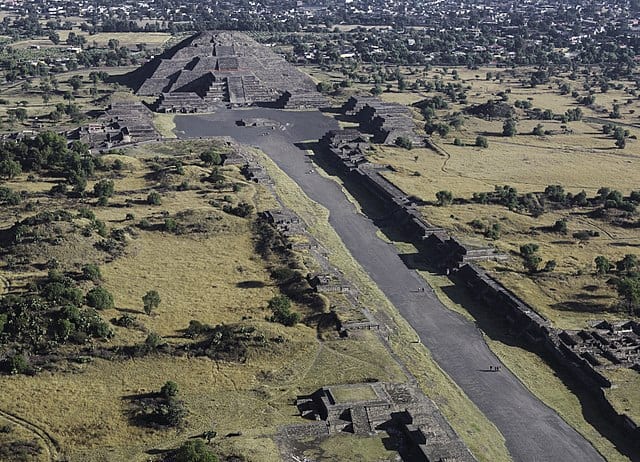
Teotihuacan is an ancient Mesoamerican city located in a sub-valley of the Valley of Mexico, which is located in the State of Mexico, 40 kilometres (25 mi) northeast of modern-day Mexico City. Teotihuacan is known today as the site of many of the most architecturally significant Mesoamerican pyramids built in the pre-Columbian Americas. At its zenith, perhaps in the first half of the first millennium (1 CE to 500 CE), Teotihuacan was the largest city in the pre-Columbian Americas, with a population estimated at 125,000 or more, making it at least the sixth-largest city in the world during its epoch. After the collapse of Teotihuacan, central Mexico was dominated by the Toltecs of Tula until about 1150 CE.
The city covered eight square miles; 80 to 90 percent of the total population of the valley resided in Teotihuacan. Apart from the pyramids, Teotihuacan is also anthropologically significant for its complex, multi-family residential compounds, the Avenue of the Dead, and its vibrant, well-preserved murals. Additionally, Teotihuacan exported fine obsidian tools that are found throughout Mesoamerica. The city is thought to have been established around 100 BCE, with major monuments continuously under construction until about 250 CE. The city may have lasted until sometime between the 7th and 8th centuries CE, but its major monuments were sacked and systematically burned around 550 CE.
Read More About Teotihuacan / Source
Celts
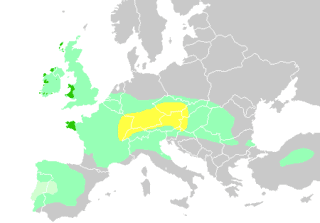
The Celts are a collection of Indo-European peoples in parts of Europe and Anatolia identified by their use of the Celtic languages and other cultural similarities. The history of pre-Celtic Europe and the relationship between ethnicity, language and culture in the Celtic world is unclear and controversial. In particular, there is dispute over the ways in which the Iron Age inhabitants of Britain and Ireland should be regarded as Celts.
According to one theory, the proto-Celtic language arose in the Late Bronze Age Urnfield culture of central Europe, which flourished from around 1200 BC. This theory links the Celts with the Iron Age Hallstatt culture which followed it (c. 800–450 BC), named for the rich grave finds in Hallstatt, Austria. Therefor, this area of central Europe is sometimes called the “Celtic homeland”. It proposes that by the following La Tène cultural period (c. 450 BC onward), named after the La Tène site in Switzerland, Celtic culture had spread by trans-cultural diffusion or migration to most of central Europe, France and the Low Countries (Gauls), the British Isles (Insular Celts), the Iberian Peninsula (Celtiberians, Celtici and Gallaeci) and northern Italy (Lepontii and Cisalpine Gauls). Another theory suggests that proto-Celtic arose earlier in the Atlantic Bronze Age coastal area and spread eastwards.
Read More About Celts / Source
Kingdom of Judah
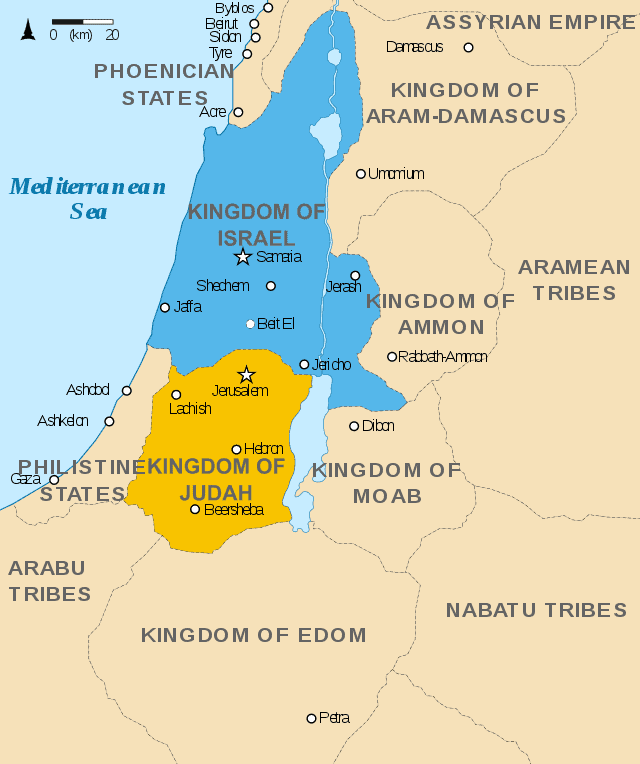
The Kingdom of Judah was an Iron Age kingdom of the Southern Levant. The Hebrew Bible depicts it as the successor to the United Monarchy, a term denoting the Kingdom of Israel under biblical kings Saul, David and Solomon and covering the territory of two historical kingdoms, Judah and Israel. However, some scholars, including Israel Finkelstein and Alexander Fantalkin, believe that the existent archaeological evidence for an extensive Kingdom of Judah before the late 8th century BCE is too weak and that the methodology used to obtain the evidence is flawed. The Tel Dan Stele shows that the kingdom, in some semblance, existed by at least the mid-9th century BCE, but it does little to show to what extent.
Read More About Kingdom of Judah / Source
Kingdom of Kush
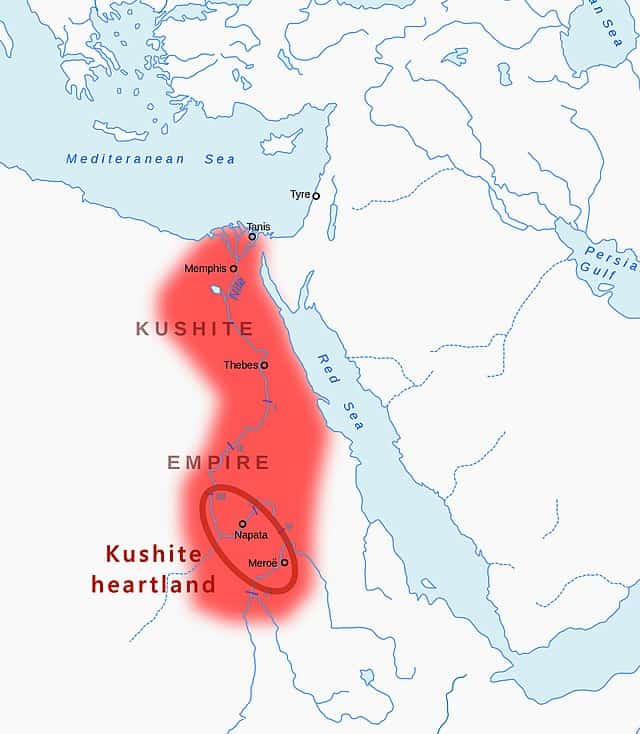
The Kingdom of Kush was an ancient kingdom in Nubia, centered along the Nile Valley in what is now northern Sudan and southern Egypt.
The region of Nubia was an early cradle of civilization, producing several complex societies that engaged in trade and industry. The city-state of Kerma emerged as the dominant political force between 2450 and 1450 BC, controlling the Nile Valley between the first and fourth cataracts, an area as large as Egypt. The Egyptians were the first to identify Kerma as “Kush” and over the next several centuries the two civilizations engaged in intermittent warfare, trade, and cultural exchange.Much of Nubia came under Egyptian rule during the New Kingdom period (1550-1070 BC). Following Egypt’s disintegration amid the Late Bronze Age collapse, the Kushites reestablished a kingdom in Napata (now modern Karima, Sudan).
Read More About Kingdom of Kush / Source
Vikings
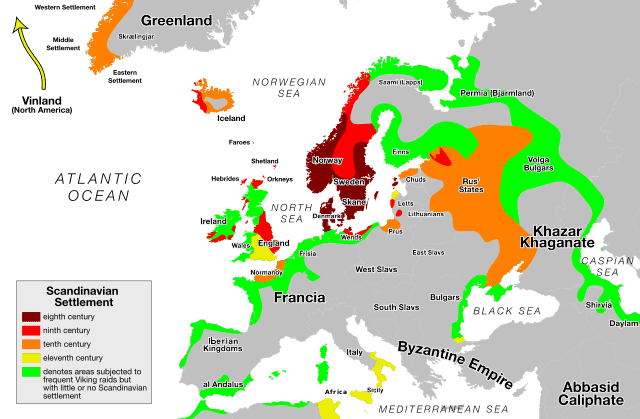
Vikings were the seafaring Norse people from southern Scandinavia (present-day Denmark, Norway and Sweden) who from the late 8th to late 11th centuries raided, pirated, traded and settled throughout parts of Europe. They explored both westward to England, Iceland, Greenland, and Vinland as well as eastward and southward through Russia to Constantinople, Iran, and Arabia. In the countries they raided and settled, the period is known as the Viking Age, and the term ‘Viking’ also commonly includes the inhabitants of the Norse homelands. The Vikings had a profound impact on the early medieval history of Scandinavia, the British Isles, France, Estonia, and Kievan Rus’.
Read More About Vikings / Source
Thracians
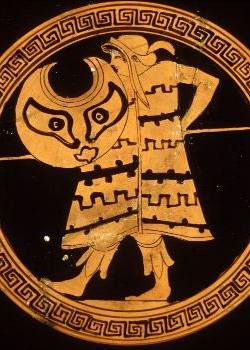
The Thracians (; Ancient Greek: Θρᾷκες Thrāikes; Latin: Thraci) were an Indo-European speaking people who inhabited large parts of Eastern and Southeastern Europe in ancient history. Thracians resided mainly in the Balkans, but were also located in Asia Minor and other locations in Eastern Europe. The exact origin of Thracians is unknown, but it is believed that proto-Thracians descended from a purported mixture of Proto-Indo-Europeans and indigenous peoples during the second millennium BC. The proto-Thracian culture developed into the Dacian and Thracian culture.
Thracian culture was described as tribal by the ancient Greeks and Romans. They remained largely disunited with the first permanent state being the Odrysian kingdom in the fifth century BC. They faced subjugation by the Achaemenid Empire around the same time. Thracians experienced a short period of peace after the Persians were defeated by the Greeks in the Persian Wars. The Odrysian kingdom lost independence to Macedonia in the late 4th century BC, and never regained total independence following Alexander the Great’s death. The Thracians faced conquest by the Romans in the mid second century BC under whom they faced internal strife. They composed major parts of rebellions against the Romans along with the Macedonians until the Third Macedonian War. Thracians were integrated into Roman society and later converted to Christianity. The last reported use of a Thracian language was by monks in the sixth century AD.
Read More About Thracians / Source
Thule Civilization
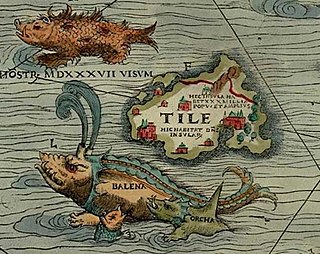
Thule is the farthest north location mentioned in ancient Greek and Roman literature and cartography. Modern interpretations have included Orkney, Shetland, northern Scotland, the island of Saaremaa (Ösel) in Estonia, and the Norwegian island of Smøla.In classical and medieval literature, ultima Thule (Latin “farthermost Thule”) acquired a metaphorical meaning of any distant place located beyond the “borders of the known world”.By the Late Middle Ages and early modern period, the Greco-Roman Thule was often identified with the real Iceland or Greenland. Sometimes Ultima Thule was a Latin name for Greenland, when Thule was used for Iceland. By the late 19th century, however, Thule was frequently identified with Norway.In 1910, the explorer Knud Rasmussen established a missionary and trading post in north-western Greenland, which he named “Thule” (later Qaanaaq). Thule has given its name to the northernmost United States Air Force airfield, Thule Air Base in northwest Greenland, and to the smaller lobe of Kuiper belt object 486958 Arrokoth, visited by the New Horizons spacecraft.
Read More About Thule Civilization / Source
Urnfield culture
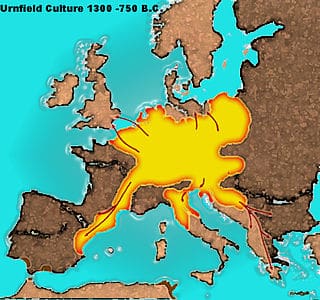
The Urnfield culture (c. 1300 BC – 750 BC) was a late Bronze Age culture of Central Europe, often divided into several local cultures within a broader Urnfield tradition. The name comes from the custom of cremating the dead and placing their ashes in urns which were then buried in fields. Over much of Europe, the Urnfield culture followed the Tumulus culture and was succeeded by the Hallstatt culture. Some linguists, such as Peter Schrijver, have suggested that the people of this area may have spoken a form of Italo-Celtic, and suggest that the Proto-Celtic language may originate from a north-western Italian dialect of this language family.
Read More About Urnfield culture / Source
Villanovan culture
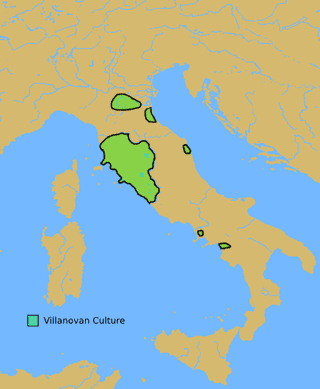
The Villanovan culture (c. 900–700 BC), regarded as the earliest phase of the Etruscan civilization, was the earliest Iron Age culture of Central Italy and Northern Italy. It directly followed the Bronze Age Proto-Villanovan culture which branched off from the Urnfield culture of Central Europe. This gave way in the 7th century BC to an increasingly orientalizing culture influenced by Greek traders and colonists who settled in South Italy.
The Villanovans introduced iron-working to the Italian Peninsula. They practiced cremation and buried the ashes of their dead in pottery urns of distinctive double-cone shape.
Read More About Villanovan culture / Source
Vinca culture
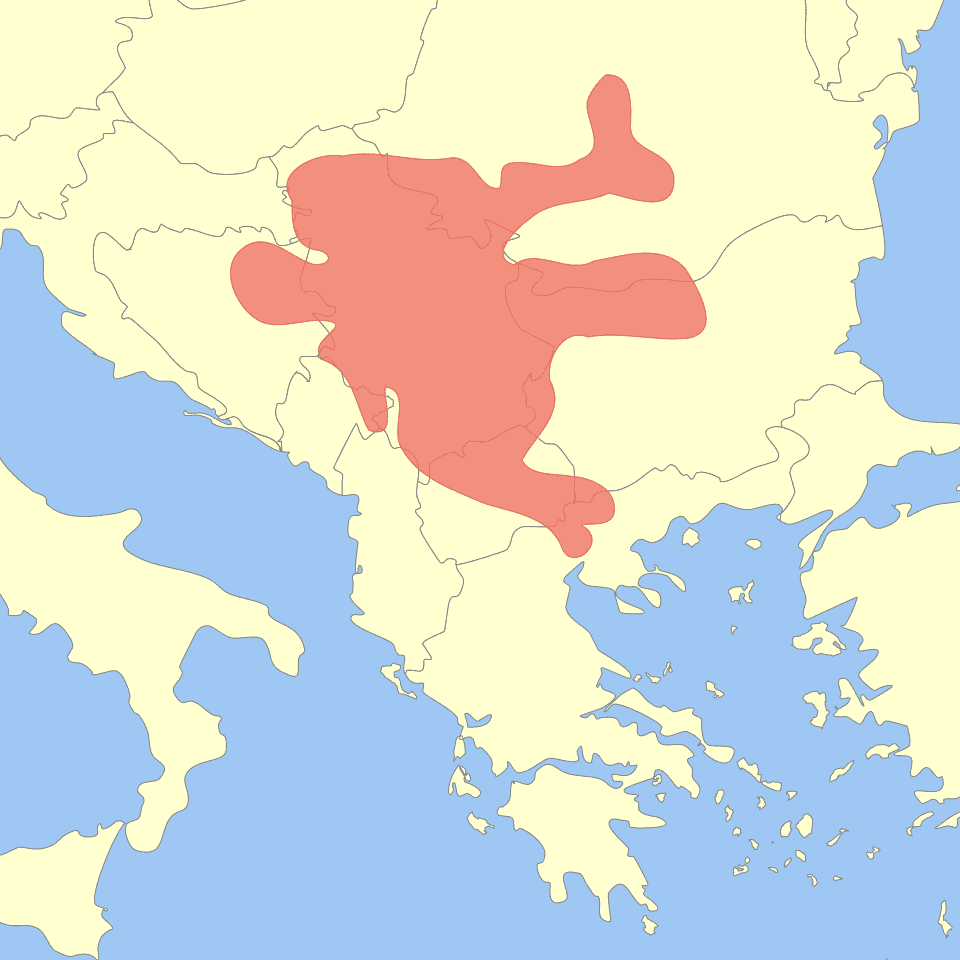
The Vinča culture, also known as Turdaș culture or Turdaș–Vinča culture, was a Neolithic archaeological culture in southeastern Europe, in present-day Serbia, and smaller parts of Bulgaria, Kosovo, Macedonia and Romania (particularly Transylvania), dated to the period 5700–4500 BC or 5300–4700/4500 BC. Named for its type site, Vinča-Belo Brdo, a large tell settlement discovered by Serbian archaeologist Miloje Vasić in 1908, it represents the material remains of a prehistoric society mainly distinguished by its settlement pattern and ritual behaviour.
Farming technology first introduced to the region during the First Temperate Neolithic was developed further by the Vinča culture, fuelling a population boom and producing some of the largest settlements in prehistoric Europe. These settlements maintained a high degree of cultural uniformity through the long-distance exchange of ritual items, but were probably not politically unified. Various styles of zoomorphic and anthropomorphic figurines are hallmarks of the culture, as are the Vinča symbols, which some conjecture to be the earliest form of proto-writing. Although not conventionally considered part of the Chalcolithic or “Copper Age”, the Vinča culture provides the earliest known example of copper metallurgy.
Read More About Vinca culture / Source
Woodland period
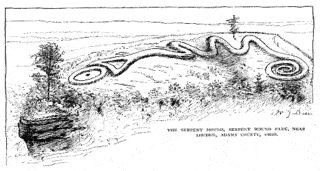
In the classification of archaeological cultures of North America, the Woodland period of North American pre-Columbian cultures spanned a period from roughly 1000 BCE to European contact in the eastern part of North America, with some archaeologists distinguishing the Mississippian period, from 1000 CE to European contact as a separate period. The term “Woodland Period” was introduced in the 1930s as a generic term for prehistoric sites falling between the Archaic hunter-gatherers and the agriculturalist Mississippian cultures. The Eastern Woodlands cultural region covers what is now eastern Canada south of the Subarctic region, the Eastern United States, along to the Gulf of Mexico.This period is variously considered a developmental stage, a time period, a suite of technological adaptations or “traits”, and a “family tree” of cultures related to earlier Archaic cultures. It can be characterized as a chronological and cultural manifestation without any massive changes in a short time but instead having a continuous development in stone and bone tools, leather crafting, textile manufacture, cultivation, and shelter construction. Many Woodland peoples used spears and atlatls until the end of the period, when they were replaced by bows and arrows; however, Southeastern Woodland peoples also used blowguns.
Read More About Woodland period / Source
Yangshao culture
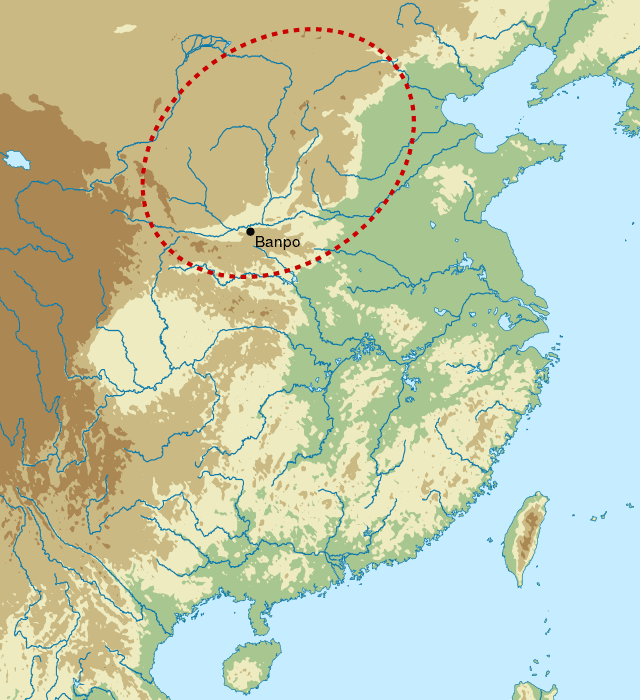
The Yangshao culture was a Neolithic culture that existed extensively along the Yellow River in China. It is dated from around 5000 BC to 3000 BC. The culture is named after the Yangshao site, the first excavated site of this culture, which was discovered in 1921 in Yangshao town, Mianchi County, Henan Province by the Swedish geologist Johan Gunnar Andersson (1874–1960). The culture flourished mainly in the provinces of Henan, Shaanxi and Shanxi.
Recent research indicates a common origin of the Sino-Tibetan languages with the Cishan, Yangshao and/or the Majiayao cultures.
Read More About Yangshao culture / Source
Yayoi period
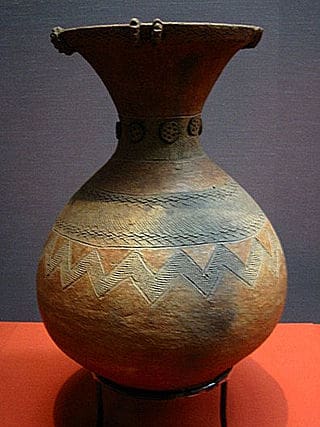
The Yayoi period, started at the beginning of the Neolithic in Japan, continued through the Bronze Age, and towards its end crossed into the Iron Age.Since the 1980s, scholars have argued that a period previously classified as a transition from the Jōmon period should be reclassified as Early Yayoi. The date of the beginning of this transition is controversial, with estimates ranging from the 10th to the 6th centuries BC.The period is named after the neighborhood of Tokyo where archaeologists first uncovered artifacts and features from that era. Distinguishing characteristics of the Yayoi period include the appearance of new Yayoi pottery styles and the start of an intensive rice agriculture in paddy fields. A hierarchical social class structure dates from this period and has its origin in China. Techniques in metallurgy based on the use of bronze and iron were also introduced from China via Korea to Japan in this period.
The Yayoi followed the Jōmon period (14,000 BC – 1,000 BC) and Yayoi culture flourished in a geographic area from southern Kyūshū to northern Honshū. Archaeological evidence supports the idea that during this time, an influx of farmers (Yayoi People) from the Korean Peninsula to Japan overwhelmed, killed off and/or mixed with the native hunter-gatherer population (Jomon People). Modern Japanese are descendants of the Yayoi people (mainly from the Korean Peninsula) with only a very small to moderate influence from the former Jōmon hunter-gatherers, depending on the region.
Read More About Yayoi period / Source










